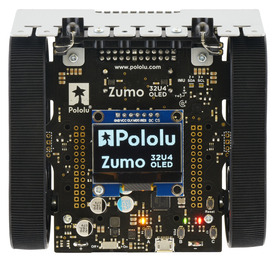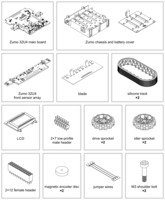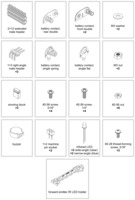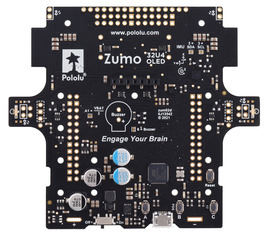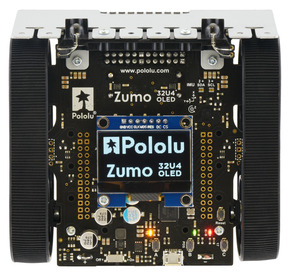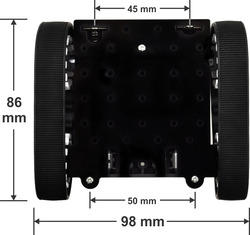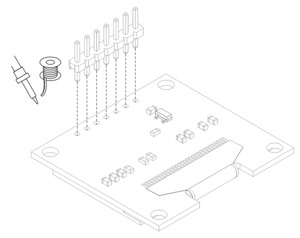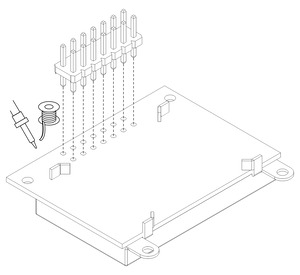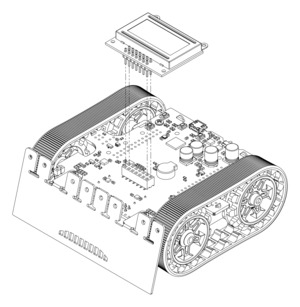Support »
Pololu Zumo 32U4 Robot User’s Guide
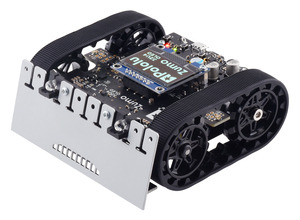
View document on multiple pages.
You can also view this document as a printable PDF.
- 1. Overview
- 2. Contacting Pololu
- 3. The Zumo 32U4 in detail
- 3.1. Microcontroller
- 3.2. User interface
- 3.3. Motors
- 3.4. Quadrature encoders
- 3.5. Front sensor array (line and proximity sensors)
- 3.6. Proximity sensing
- 3.7. Inertial sensors
- 3.8. Power
- 3.9. Expansion areas
- 3.10. Pin assignments
- 3.11. Adding electronics
- 3.12. AVR timers
- 3.13. Schematics and dimensions
- 4. Assembling the Zumo 32U4 kit
- 5. Programming the Zumo 32U4
- 6. Zumo 32U4 Arduino library
- 7. The Zumo 32U4 USB interface
- 8. The A-Star 32U4 Bootloader
- 9. Reviving an unresponsive Zumo 32U4
- 10. Related resources
1. Overview
 |
The Zumo 32U4 robot is a complete, versatile robot controlled by an Arduino-compatible ATmega32U4 microcontroller. When assembled, the low-profile tracked robot measures less than 10 cm on each side, making it suitable for Mini-Sumo competitions.
At the heart of the Zumo 32U4 is an integrated ATmega32U4 AVR microcontroller from Atmel, along with dual H-bridge drivers that power the robot’s motors. The robot also features a variety of sensors, including quadrature encoders and inertial sensors (accelerometer and gyro) on the main board, along with reflectance and proximity sensors on the front sensor array. On-board pushbuttons offer a convenient interface for user input, and a 128×64 graphical OLED display (LCD on original version), buzzer, and indicator LEDs allow the robot to provide feedback.
Like our A-Star 32U4 programmable controllers, the Zumo 32U4 features a USB interface and ships preloaded with an Arduino-compatible bootloader. We provide a software add-on that makes it easy to program the Zumo 32U4 from the Arduino environment, as well as a set of Arduino libraries to help interface with its on-board hardware.
Zumo 32U4 versions
The original version of the Zumo 32U4 includes an 8×2 character LCD, while the newer Zumo 32U4 OLED incorporates a graphical OLED display instead. The information in this user’s guide generally applies to both versions, and the name “Zumo 32U4” covers both the original (LCD) and OLED versions except where specific differences are noted.
Our Zumo3U4 Arduino library generally allows code written for the LCD version to work on the OLED version with minimal changes (and the reverse is also true as long as your code does not make use of the OLED’s graphical capabilities).
|
|
The LCD version of the Zumo 32U4 main board has been produced in two revisions that use different on-board inertial sensor ICs: v1.0 boards had an LSM303D accelerometer and magnetometer and L3GD20H gyro, while v1.1 boards have an LSM6DS33 accelerometer and gyro and an LIS3MDL magnetometer (the same sensors used on the OLED version).
Comparison with the Zumo robot kit for Arduino (with Zumo Shield)
Our older Zumo robot for Arduino, built with a Zumo Shield, is another Arduino-compatible robotic platform based on the Zumo chassis. The Zumo Shield is designed for a board with a standard Arduino form factor, like an Arduino Uno, Arduino Leonardo, or A-Star 32U4 Prime, to plug into it and act as its controller.
|
|
By contrast, the Zumo 32U4 includes an on-board ATmega32U4 microcontroller (the same one used in the Leonardo and A-Star 32U4 boards), combining the functions of the Zumo Shield and the separate Arduino controller into a single board and enabling the resulting robot to be even more compact. However, it remains just as easy to program as a standard Arduino, thanks to its USB interface and preloaded Arduino-compatible bootloader. The Zumo 32U4 also adds many features that are not found on the Zumo Shield, including encoders, an OLED display or LCD, and proximity detection.
Some of the pin mappings and software libraries differ between the Zumo 32U4 and Zumo robot for Arduino, so programs written for one robot generally need to be modified to work on the other.
1.1. Configurations and included components
The Zumo 32U4 OLED robot is available in several configurations:
- Zumo 32U4 OLED Robot Kit (No Motors) – requires assembly and soldering; can be customized with your choice of motors (not included)
- Zumo 32U4 OLED Robot (assembled with 50:1 HP motors)
- Zumo 32U4 OLED Robot (assembled with 75:1 HP motors)
- Zumo 32U4 OLED Robot (assembled with 100:1 HP motors)
In addition, the Zumo 32U4 OLED Main Board is available separately; it is primarily intended as a replacement part, but it can also be used to make your own Zumo 32U4 OLED robot if you do not want all of the parts included with our full kit.
The original (LCD) version of the Zumo 32U4 robot is also available as a kit or assembled with 50:1, 75:1, or 100:1 motors, and its control board can also be purchased separately.
Zumo 32U4 robot kit contents
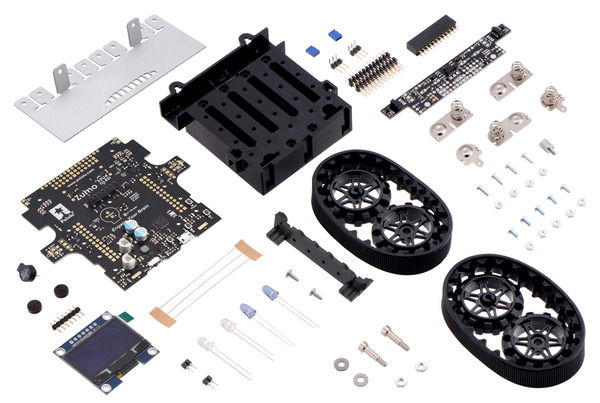 |
Contents of the Zumo 32U4 OLED robot kit. |
|---|
The kit version of the Zumo 32U4 OLED robot includes the following items:
- Zumo Chassis Kit, which includes:
- Zumo chassis main body
- two drive sprockets
- two idler sprockets
- two 22-tooth silicone tracks
- two shoulder bolts with washers and M3 nuts
- four 1/4″ #2-56 screws and nuts
- battery terminals
- Zumo 32U4 OLED Main Board, which includes:
- two 1×2 machine pin sockets for IR LEDs
- buzzer
- 1×7 low-profile male header for OLED display (original version kits include an 2×7 low-profile male header for the LCD instead)
- jumper wires (for soldering motors to the main board)
- two magnetic encoder discs (12 CPR)
- 2×12 female header for front sensor array
- five 3/16″ #2-56 screws and nuts (original version kits only include four sets)
- 1/4″ #2-56 standoff (OLED version only)
- Zumo 32U4 Front Sensor Array, which includes:
- 2×12 extended male header for sensor array
- two 1×3 right-angle male headers and two shorting blocks – jumpers for sensor array
- two wide-angle and two narrow-angle through-hole infrared LEDs (these plug into the main board and serve as forward emitters for the proximity sensor detectors located on the front sensor array)
- Zumo 32U4 Blade, which includes
- forward IR emitter LED holder
- two 3/16″ #2-28 thread-forming screws for LED holder
- graphical OLED display (original version kits include an 8×2 character LCD instead)
 |
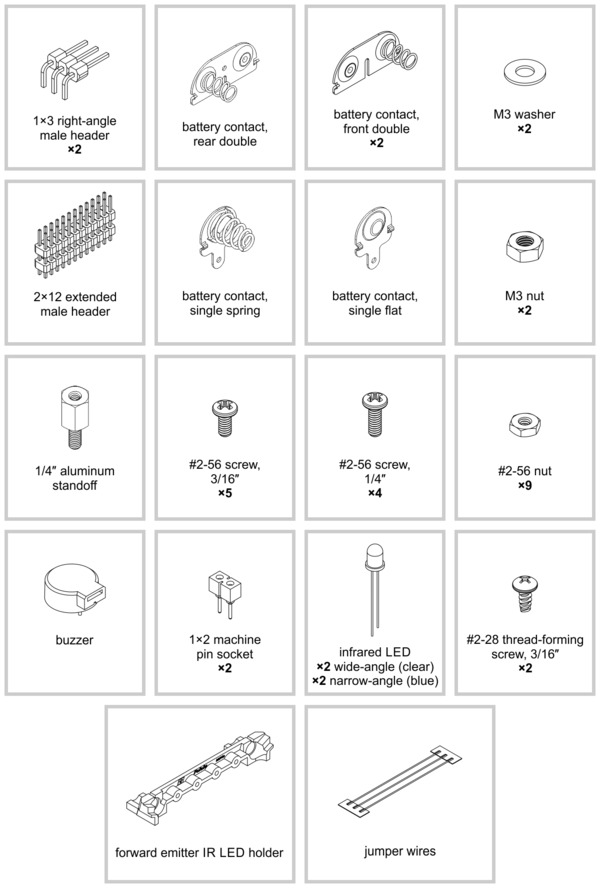 |
The diagrams above show the contents of the Zumo 32U4 OLED Kits. For the contents of the original Zumo 32U4 Kit, which includes an LCD and differ in a few other parts, refer to these diagrams instead.
|
|
The robot and chassis kit might include extra parts like jumper wires, screws, nuts, washers, and an acrylic spacer plate (which is not used in the Zumo 32U4), so do not be concerned if you have some leftover hardware after assembling your Zumo. Your kit might also include a length of heat shrink tubing that can be used as shrouds for IR LEDs. Kits shipped before August 2015 include heat shrink tubing but do not include the LED holder and its mounting screws.
Assembled Zumo 32U4 robot
 |
The assembled versions of the Zumo 32U4 robot are complete, ready-to-program robot platforms built from the same components found in the Zumo 32U4 Robot Kit; no soldering or assembly is required. A choice of three motor gear ratios offer different combinations of torque and speed.
Different versions of the assembled Zumo 32U4 robots can be identified with a sticker on the underside of the main board, visible inside the battery compartment of the Zumo without batteries installed. The color of the sticker indicates the gear ratio of the robot’s motors:
- Green: 50:1 HP
- Blue: 75:1 HP
- Red: 100:1 HP
The assembled Zumo 32U4 robot is fitted with wide-angle IR emitter LEDs (clear); the narrow-angle LEDs (blue) are not included.
1.2. What you will need
These additional items are needed for using the Zumo 32U4 robot:
 |
Micro Metal Gearmotor with Extended Motor Shaft. |
|---|
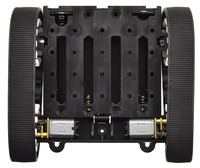 |
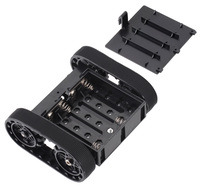 |
- four AA batteries—the robot works with both alkaline and NiMH batteries, though we recommend using rechargeable AA NiMH cells
- USB A to Micro-B cable to connect the robot to your computer for programming and debugging
- small 2 mm slotted screwdriver for adjusting the LCD contrast (original LCD version only)
In addition, the kit version of the robot requires:
- two micro metal gearmotors with extended motor shafts (see below)
Kit motor selection
The kit version of the Zumo 32U4 robot requires the addition of two micro metal gearmotors with extended motor shafts, one for each tread.
The ideal motors for your robot depend on your desired torque, speed, and current draw. We generally recommend using HP versions of our micro metal gearmotors since the tracks require a decent amount of torque to move effectively; higher gear ratios of the non-HP motors might work if you want lower current draw, but they will be slower and offer less control.
If you are unsure which motors to choose, we recommend getting two of the 75:1 Micro Metal Gearmotor HP with Extended Motor Shaft, which offer a good balance of performance characteristics, and most of our example code was developed and tested with these motors. 50:1 HP and 100:1 HP motors also generally work well. These three motor types are the ones we offer in assembled Zumo 32U4 robots.
The following table summarizes the key specifications of the recommended 50:1 HP, 75:1 HP, and 100:1 HP motors. The first four columns are specifications of the motors themselves, while the last column is the measured top speed of a Zumo chassis loaded to a weight of 500 g and driven with these motors. Note that the specifications are for 6V operation, which is approximately the voltage you would get with four fresh alkaline batteries; four NiMH AA cells will typically provide less than 5V.
| Micro Metal Gearmotor |
Free-Run Speed @ 6V |
Stall Torque @ 6V |
Stall Current @ 6V |
Top Zumo Speed @ 6V and 500g |
|
|---|---|---|---|---|---|
| 50:1 HP | 625 RPM | 15 oz·in | 1600 mA | 40 in/s | (100 cm/s) |
| 75:1 HP | 400 RPM | 22 oz·in | 1600 mA | 25 in/s | (65 cm/s) |
| 100:1 HP | 320 RPM | 30 oz·in | 1600 mA | 20 in/s | (50 cm/s) |
For more options, you can see our other micro metal gearmotors with extended motor shafts. Be sure to pick a motor that has an extended shaft, or else you will not be able to use the encoders on the Zumo 32U4.
Kit assembly tools
These additional items are needed for assembling the Zumo 32U4 robot kit:
- soldering iron and solder (we recommend one with adjustable temperature control)
- wire cutter
- small #1 Phillips screwdriver
- 3 mm Allen wrench (hex key)
- long-nose pliers (for bending the IR LED leads and Zumo 32U4 blade mounting tabs)
- tape or small clamps (for holding parts together when soldering)
Additional optional components
You might also consider getting these for your Zumo 32U4 robot:
- Sensors, such as optical or sonar range finders (the Zumo 32U4 already has built-in IR proximity sensors, but additional sensors can be incorporated for increased range or detection area)
- Connectors and jumper wires, for connecting additional sensors and components
- Battery charger, if you are using rechargeable batteries; since the Zumo just uses ordinary AA batteries, we recommend basic AA chargers (into which you stick the individual cells) available at most general electronics stores, though we carry a much fancier iMAX-B6AC V2 balance charger/discharger that can be also used for this
1.3. Supported operating systems
The Zumo 32U4 can be programmed using current versions of Microsoft Windows 11, Windows 10, Linux, and macOS. See our A-Star 32U4 bootloader page on GitHub for a list of older operating systems that have been tested with the bootloader and are likely to work.
2. Contacting Pololu
We would be delighted to hear from you about your experiences with the Zumo 32U4 robot. If you need technical support or have any feedback you would like to share, you can contact us directly or post on our forum. Tell us what we did well, what we could improve, what you would like to see in the future, or anything else you would like to say!
3. The Zumo 32U4 in detail
3.1. Microcontroller
The Zumo 32U4 main board features an integrated, USB-enabled ATmega32U4 AVR microcontroller from Atmel, clocked by a precision 16 MHz crystal oscillator. This is the same microcontroller and clock frequency used in our family of A-Star 32U4 programmable controllers, as well as the Arduino Leonardo and Arduino Micro.
The main board includes a USB Micro-B connector that can be used to connect to a computer’s USB port via a USB A to Micro-B cable (not included). The USB connection can be used to transmit and receive data from the computer and program the board over USB. The USB connection also provides power for the microcontroller and most of the other hardware on the Zumo (but not motor power); see Section 3.8 for more details.
The Zumo’s ATmega32U4 comes preloaded with the same Arduino-compatible USB bootloader as the A-Star 32U4, which allows it to be easily programmed using the Arduino IDE. For more information about programming the Zumo 32U4, see Section 5.
3.2. User interface
|
|
LEDs
The Zumo 32U4 has eight indicator LEDs.
- A yellow user LED is connected to Arduino digital pin 13, or PC7. You can drive this pin high in a user program to turn this LED on. The Zumo’s A-Star 32U4 Bootloader fades this LED on and off while it is waiting for a sketch to be loaded.
- A green user LED is connected to PD5 and lights when the pin is driven low. While the board is running the A-Star 32U4 Bootloader or a program compiled in the Arduino environment, it will flash this LED when it is transmitting data via the USB connection.
- A red user LED is connected to Arduino pin 17, or PB0, and lights when the pin is driven low. While the board is running the A-Star 32U4 Bootloader or a program compiled in the Arduino environment, it will flash this LED when it is receiving data via the USB connection.
The Zumo32U4 library contains functions that make it easier to control the three user LEDs (see Section 6). Some of the LED control lines are also display interface lines (green and red on the OLED version; all three LEDs on the original LCD version), so you will see them flicker when you update the display. The green and red user LEDs also share I/O lines with pushbuttons (see below).
- Two red LEDs on the left and right edges of the board indicate when the robot’s infrared emitters are active on the corresponding side.
- Two blue power LEDs under the rear corners of the main board indicate when the robot is receiving power from batteries (the power switch must be turned on). The left LED is connected to the reverse-protected and switched battery voltage (VBAT), while the right LED is connected to the output of the main board’s 5 V regulator.
The left blue LED will become noticeably dimmer as the total battery voltage drops below about 3 V, and this can serve as an indication that a set of alkaline batteries has reached the end of its useful life. However, rechargeable batteries can be damaged by overdischarge, so we do not recommend allowing a set of four NiMH cells to discharge to this point. (A voltage divider is connected to analog pin 1 and can be used to monitor the battery voltage; see Section 3.8 for details.)
- A green power LED under the center rear edge of the main board indicates when the USB bus voltage (VBUS) is present.
Pushbuttons
The Zumo 32U4 has four pushbuttons: a reset button on the right edge and three user pushbuttons located along the rear edge of the main board. The user pushbuttons, labeled A, B, and C, are on Arduino pin 14 (PB3), PD5, and Arduino pin 17 (PB0), respectively. Pressing one of these buttons pulls the associated I/O pin to ground through a resistor.
The three buttons’ I/O lines are also used for other purposes: pin 14 is MISO on the SPI interface, PD5 and pin 17 control the green and red user LEDs, and some pins are display interface lines (pin 30 and pin 17 on the OLED version; all three buttons on the original LCD version). Although these uses require the pins to be driven by the AVR (or SPI slave devices in the case of MISO), resistors in the button circuits ensure that the Zumo will not be damaged even if the corresponding buttons are pressed at the same time, nor will SPI or display communications be disrupted. The functions in the Zumo32U4 library take care of configuring the pins, reading and debouncing the buttons, and restoring the pins to their original states.
Display header
The Zumo 32U4 OLED has a 1×7 header where you can connect a graphical OLED module with a low-profile male header. The included display has a resolution of 128×64 pixels and uses an SH1106 controller (1MB pdf), which the Zumo communicates with via software SPI. On-board level shifters convert 5 V signals from the Zumo’s microcontroller to the 3.3 V logic level required by the OLED module.
The original Zumo 32U4 has a 2×7 header where you can connect an 8×2 character LCD with a low-profile male header (or any other LCD with the common HD44780 parallel interface (109k pdf)). You can adjust the LCD contrast with the potentiometer directly above the LCD connector. We recommend using a 2 mm slotted screwdriver to adjust the contrast.
The Zumo32U4 library provides functions to show data on a connected display. It is designed to gracefully handle alternate use of the display interface lines by only changing pin states when needed for a display command, after which it will restore them to their previous states. This allows the display interface lines to be used for other functions (such as pushbutton inputs and LED drivers).
Although the OLED and LCD screens have different hardware interfaces, the library presents similar software interfaces for both that generally allow code written for the original (LCD) version of the Zumo 32U4 to work on the OLED version with minimal changes. The reverse is also true as long as your code does not make use of the OLED’s graphical capabilities.
Buzzer
The buzzer on the Zumo 32U4 can be used to generate simple sounds and music. By default, it is connected to digital pin 6 (which also serves as OC4D, a hardware PWM output from the AVR’s 10-bit Timer4). If you alternate between driving the buzzer pin high and low at a given frequency, the buzzer will produce sound at that frequency. You can play notes and music with the buzzer using functions in the Zumo32U4Buzzer library. If you want to use pin 6 for an alternate purpose, you can disconnect the buzzer circuit by cutting the surface-mount jumper next to the buzzer.
3.3. Motors
Two on-board Texas Instruments DRV8838 motor drivers power the Zumo 32U4’s two micro metal gearmotors. Four Arduino pins are used to control the drivers:
- Digital pin 15, or PB1, controls the right motor direction (LOW drives the motor forward, HIGH drives it in reverse).
- Digital pin 16, or PB2, controls the left motor direction.
- Digital pin 9, or PB5, controls the right motor speed with PWM (pulse width modulation) generated by the ATmega32U4’s Timer1.
- Digital pin 10, or PB6, controls the left motor speed with PWM.
For more information about the drivers, see the DRV8838 datasheet (1k redirect). We also sell a carrier board for this driver.
The Zumo32U4 library provides functions that allow you to easily control the motors, and it can optionally take care of flipping a direction signal for you if you accidentally soldered in a motor backwards (see Section 6).
As your batteries run out, the voltage supplied to the motor drivers (VBAT) will decrease, which will make the motors slower. It is possible to account for this in your code by monitoring the battery voltage (see Section 3.8) or using the encoders and other sensors to monitor the movement of the robot.
3.4. Quadrature encoders
 |
Each drive motor on the Zumo 32U4 has a corresponding quadrature encoder system consisting of a magnetic disc attached to the extended motor shaft and a pair of Hall effect sensors mounted to the underside of the main board. Other than the sensor orientation, these encoders work similarly to our magnetic encoder kits for micro metal gearmotors. They can be used to track the rotational speed and direction of the robot’s drive sprockets.
The encoders provide a resolution of 12 counts per revolution of the motor shaft when counting both edges of both channels. To compute the counts per revolution of the drive sprockets, multiply the gearboxes’ gear ratio by 12. For example, if 75:1 motors (which have gear ratios more accurately specified as 75.81:1) are used, the encoders provide 75.81 × 12 ≈ 909.7 CPR.
Quadrature encoder transitions are often detected by monitoring both encoder channels directly. However, since transitions on the Zumo’s encoders can occur at high frequencies (several thousand per second) when its motors are running, it is necessary to use the AVR’s pin change interrupts or external interrupts to read the encoders. To reduce the required number of interrupt pins, the Zumo 32U4 main board XORs together both channels of each encoder and connects the resulting signal to an interrupt pin, while channel B of each encoder is connected to a non-interrupt pin:
- Digital pin 7, or PE6, reads the right encoder XORed signal using external interrupt INT6.
- Digital pin 8, or PB4, reads the left encoder XORed signal using pin change interrupt PCINT4.
- Digital pin 23 (analog pin 5), or PF0, reads the right encoder channel B.
- Pin PE2 reads the left encoder channel B.
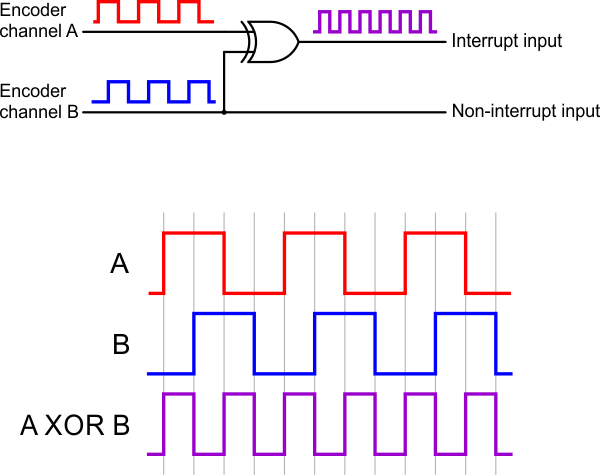 |
The XORed signal and the channel B signal can be used to reconstruct the channel A signal by simply XORing them again: (A XOR B) XOR B = A. For both encoders, channel A leads channel B when the motor is rotating in the forward direction; that is, A rises before B rises and A falls before B falls. (The waveforms in the diagram above would be produced by forward rotation.)
The Zumo 32U4 library provides appropriate interrupt service routines and functions for reading the encoders and keeping track of their counts (see Section 6).
3.5. Front sensor array (line and proximity sensors)
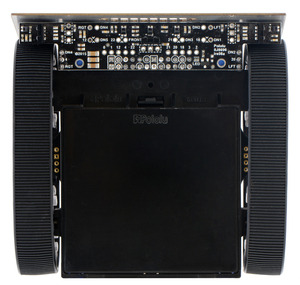 |
The Zumo 32U4 Front Sensor Array is a separate board that attaches to the main board. The board features five line sensors and three proximity sensors, though by default, you can only have six of these eight sensors connected to the Zumo’s microcontroller at any given time.
The five line sensors face downward and can help the Zumo distinguish between light and dark surfaces. They can also be used to detect sources of infrared light, like the sun. Each reflectance sensor consists of a down-facing infrared (IR) emitter LED paired with a phototransistor that can detect reflected infrared light from the LED. The reflectance sensors operate on the same principles as our QTR-1RC sensor: the AVR uses an I/O line to drive the sensor output high, and then measures the time for the output voltage to decay. The IR emitters for the reflectance sensors are on by default, but they can be turned off by driving digital pin 11 low. The five line sensors are numbered 1 through 5, with line sensor 1 being the robot’s left-most sensor. In schematics and diagrams, they are referred to as DOWN1, DOWN2, DOWN3, DOWN4, and DOWN5. On the front sensor array, their signals are labeled DN1, DN2, DN3, DN4, and DN5. The part used for the line sensors is the Sharp GP2S60 compact reflective photointerrupter (164k pdf).
The three proximity sensors face in different directions away from the Zumo and can help detect nearby objects. They can also be used to detect commands from typical IR remote controls. The proximity sensors, like the line sensors, detect reflected IR light, but they are designed to only detect light that is turned on and off quickly at a frequency of 38 kHz. To read a proximity sensor, the AVR can enable the internal pull-up on the corresponding I/O line. When the sensor is active, it will drive the line low. The proximity sensors do not have IR emitters paired with them; instead they detect reflected 38 kHz IR light that comes from LEDs on the Zumo 32U4 Main Board, which are described in Section 3.6. The proximity sensors are named after the directions they face: left, right, or front. In schematics and diagrams, they are referred to as LEFT, RIGHT, and FRONT. On the front sensor array, their signals are labeled LFT, FRONT, and RGT. The part used for the proximity sensors is the Vishay TSSP77038 IR receiver module (268k pdf). The TSSP77038 has a fixed gain (sensitivity) that makes the sensor more predictable.
Each sensor output on the front sensor array is protected by a 220 Ohm resistor to help prevent short circuits when the AVR is driving the corresponding I/O line.
The infrared emitted by the line sensors can interfere with the proximity sensors and cause false readings, so it is recommended to turn off the line sensor emitters before using the proximity sensors. The Zumo32U4ProximitySensors class from the Zumo 32U4 Arduino library takes care of turning off the line sensor emitters.
Pin assignments
By default, the front sensor array supports these pin assignments:
- Pin A0 (18) is connected to line sensor 1 (DN1),
- Pin A3 (21) is connected to line sensor 3 (DN3).
- Pin 12 is connected to line sensor 5 (DN5).
- Pin A4 (22) is connected to the front proximity sensor.
- Pin A2 (20) is connected to either the left proximity sensor (LFT) or line sensor 2 (DN2), depending on the position of a jumper.
- Pin 4 is connected to either the right proximity sensor (RGT) or line sensor 4 (DN4), depending on the position of a jumper.
- Pin 11 is connected to the line sensor emitter control pin (LEDON).
The assembled versions of the Zumo 32U4 robot ship with jumpers selecting the left (LFT) and right (RGT) proximity sensors instead of down-facing DN2 and DN4, so these versions are configured for three down-facing sensors and all three proximity sensors by default.
The signals from the sensors can be remapped by soldering in a wire from the signal output to the desired I/O pin. You would also want to disconnect the sensor output from the standard I/O pin so that pin can be used for other purposes. For line sensor 1, line sensor 3, line sensor 5, and the front proximity sensor, disconnecting the sensor involves cutting a trace between the signal output and the standard I/O pin, which is labeled on the board. For the line sensor 2, line sensor 4, the left proximity sensor, and the right proximity sensor, you can simply move or remove the corresponding jumper.
Example remapping: using all the sensors
If you want to use all five line sensors and all three proximity sensors in one application, you can accomplish that by freeing up two I/O lines and remapping two of the pins. One way to accomplish this is by removing the Zumo’s display to free up pins 0 and 1. Next, configure the jumpers on the front sensor array to connect pin 4 to line sensor 4, and pin 20 to line sensor 2. Solder a wire from the right proximity sensor signal to pin 0, and solder a wire from the left proximity sensor to pin 1. You will need to modify your code to include the new pin assignments, and you should remove all display-related code.
3.6. Proximity sensing
The Zumo 32U4 can detect nearby objects using the three proximity sensors on the front sensor array. The proximity sensors do not emit their own light; instead they are designed to detect 38 kHz infrared (IR) signals from emitters on the Zumo 32U4 Main Board.
The main board has four IR emitters:
- The middle-left and middle-right IR LEDs are surface-mounted on either side of the Zumo, inside the tracks and between the wheels. They emit light to the left and to the right.
- The front-left and front-right IR LEDs are meant to face towards the front, though you can play with the exact angle to see if it yields better results for your particular application. These LEDs are included, but they must be installed by the user, as described in Section 4.
The middle-left LED and the front-left LED are in series, so you must install the front-left LED in order to use the middle-left LED, and you cannot turn on one without turning on the other. Similarly, the middle-right and front-right IR emitters are in series.
Two AVR pins are used to control the LEDs: pin 5 (OC3A) is the proximity LED PWM pin, and must be driven high to turn on any of the LEDs. Pin A1 (19) is the proximity LED selection pin, and must be driven high or low to select which set of LEDs to turn on. If A1 is high, the right-side LEDs are selected. If A1 is low, the left-side LEDs are selected. (When A1 is an input, it can be used to read the battery voltage.) The brightness of the emitters can be controlled by adjusting the duty cycle of the PWM signal on pin 5.
Our example code operates the proximity sensors by transmitting pulses on both the left and right LEDs at six different brightness levels. For each sensor, it generates two numbers: the number of brightness levels for the left LEDs that activated the sensor, and the number of brightness levels for the right LEDs that activated the sensor. A higher reading corresponds to more IR light getting reflected to the sensor, which is influenced by the size, reflectivity, proximity, and location of nearby objects. However, the presence of other sources of 38 kHz IR pulses (e.g. from another robot) can also affect the readings.
You can also just read the proximity sensors without turning on any LEDs. This could allow the Zumo to detect the IR proximity sensors of other robots, or to detect commands from a typical IR remote.
Forward LED selection
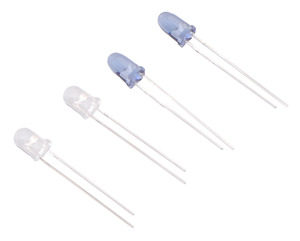 |
The kit version of the Zumo 32U4 comes with two types of through-hole IR LEDs that can be installed to serve as the forward emitters. Both types of LEDs use the T-1 3/4 package, meaning they have a diameter of approximately 5 mm. Also, they both emit 940 nm light. The main difference between these LEDs is their viewing angle. The blue-colored LEDs have a relatively narrow viewing angle of 20°, which makes them better at illuminating objects far away. The clear LEDs have a much wider 50° viewing angle, which makes them better at illuminating objects that are not directly in front of the Zumo. The choice of IR LEDs to use is one way for you to customize your Zumo.
The assembled versions of the Zumo 32U4 robot ship with clear (wide-angle) LEDs installed; blue (narrow-angle) LEDs are not included with these versions.
IR LED holder
Note: Kits shipped before August 2015 do not include the LED holder and its mounting screws. Instead, the forward IR emitter LEDs can be shielded with shrouds made from the included heat shrink tubing as described below.
Proper shielding for the forward emitters is important; without shielding, light from the LEDs can activate the proximity sensors directly and cause false readings. The Zumo 32U4 comes with a plastic LED holder that serves to shield the LEDs while also holding them in place and helping to protect them from collisions with other robots. The LED holder screws to the blade with the two included 3/16″ #2-28 thread-forming screws. See the assembly instructions in Section 4 to learn how to properly install the forward emitters with the LED holder.
 |
IR LEDs with LED holder. |
|---|
Shielding with heat shrink tubing
You can make shrouds out of black heat shrink tubing to shield the forward emitters as an alternative to using the LED holder. Without the LED holder, the LEDs are less securely mounted, but you can more easily adjust their positioning.
 |
IR LEDs with heat shrink shielding. |
|---|
You can test to see if your shielding is good by putting your Zumo on a black surface with no objects nearby and making sure that you get a reading of 0 for all the proximity sensors.
3/16″ diameter heat shrink tubing can work well (tubing of this size was included with kits prior to August 2015), but please note that the actual diameter of heat shrink tubing often differs significantly from its nominal diameter, depending on the type and manufacturer of the tubing.
Proximity sensor performance
The proximity sensors have no particular minimum sensing distance; they can sense an object that is close to the Zumo as long as the shape of that object allows some light from the LEDs to be reflected into the sensor.
The maximum sensing distance depends on the size and reflectivity of the object you are sensing. We did several tests of the front proximity sensors to see how well they could see the steel blade of another Zumo while both robots were on the black surface of a sumo ring. In these tests, we found that the maximum sensing distance was around 30 cm to 40 cm.
There is a significant dead spot between the sensing regions of the front sensor and each side sensor. Therefore, if the Zumo senses an object with the left or right sensors and then turns to face it, there will probably be a period of time where none of the sensors can see the object.
Facing towards an object
The FaceTowardsOpponent demo found in the Zumo 32U4 Arduino library (Section 6) uses the motors and the front proximity sensor to scan for nearby objects, face directly towards them, and track them if they move. To directly face an object, it compares the two readings from the front sensor: the number of brightness levels for the left LEDs that resulted in the sensor activating, and the number of brightness levels for the right LEDs that resulted in the sensor activating. If the left reading is greater than the right reading, it means the object is closer to the left LEDs, so the robot should turn left (counter-clockwise) to face it more directly. Similarly, if the right reading is greater than the left reading, the robot should turn right (clockwise). If both of the readings are below a certain threshold, then it just turns the motors in order to scan for nearby objects.
This could be a good starting point for a sumo robot that uses the front sensors to locate its opponent.
3.7. Inertial sensors
The Zumo 32U4 includes on-board sensors that can be used as an inertial measurement unit (IMU) for applications like helping your Zumo detect collisions and determine its own orientation.
The inertial sensors include a 3-axis accelerometer, 3-axis gyro, and 3-axis magnetometer, all connected to a shared I²C bus connected to the ATmega32U4’s I²C interface. The specific inertial sensor chips used on a Zumo 32U4 depend on its version:
- The Zumo 32U4 OLED and the Zumo 32U4 (original LCD version), v1.1, use an LSM6DS33 accelerometer and gyro and an LIS3MDL magnetometer.
- LSM6DS33 datasheet (1MB pdf)
- LIS3MDL datasheet (2MB pdf)
- The Zumo 32U4 (original LCD version), v1.0, uses an LSM303D accelerometer and magnetometer and an L3GD20H gyro.
- LSM303D datasheet (1MB pdf)
- L3GD20H datasheet (3MB pdf)
Level shifters built into the main board allow the inertial sensors, which operate at 3.3 V, to be connected to the ATmega32U4 (operating at 5 V). The sensors, level shifters, and I²C pull-up resistors are connected to the SDA (digital pin 2, or PD1) and SCL (digital pin 3, or PD0) pins on the AVR by default, but they can be disconnected by cutting the surface-mount jumpers labeled “2 = SDA” and “3 = SCL” on the board to allow those pins to be used for other purposes.
We recommend carefully reading the datasheets listed above to understand how these sensors work and how to use them.
Using the sensors
The Zumo32U4 library (see Section 6) includes functions that help configure and read the inertial sensors, and it abstracts details of the specific sensor ICs to make it easier to write programs that will work on all versions of the Zumo 32U4. The library includes some example programs that demonstrate how to use the sensors.
For advanced applications, you can instead use some of the dedicated libraries that we have written for these sensor chips; these include our LSM6 Arduino library, LIS3MDL Arduino library, LSM303 Arduino library, and L3G Arduino library. The Zumo 32U4 main boards use the same inertial sensor ICs as some of our IMU boards, like the MinIMU-9 v5, so Arduino software written for the MinIMU-9 (such as our AHRS example) can also be adapted to work on a Zumo 32U4.
Notes on the magnetometer
Please note that the magnetometer on the Zumo 32U4 is affected by currents in the motors and buzzer when they are operating, as well as metal in the batteries, and the readings are easily influenced by magnetic distortions in the environment around the Zumo (such as rebar in a concrete floor). As a result, it is very hard to accurately determine the Zumo’s absolute heading based on the magnetometer data. However, in our tests, we found that the magnetometer could still be useful for rough measurements of relative orientation changes; for example, once the magnetic readings are compensated for a particular environment, they can be used to help the Zumo turn left or right by a specific angle instead of just timing how long to run the motors to make such a turn (although the gyro or encoders might be better suited for this particular purpose).
In our tests, we found that the batteries, motors, and motor current affect the z axis of the magnetometer much more strongly than the x and y axes, so you probably will want to ignore the z readings. We were generally able to get decent results using only the x and y magnetometer readings to determine heading. Additionally, you might need to decrease the magnetometer sensitivity; if the magnetometer returns a value of -4096, that is a sign that the sensitivity range is set too narrow for your particular environment.
3.8. Power
The Zumo chassis has an internal compartment for four AA batteries. We recommend using rechargeable AA NiMH cells, which results in a nominal voltage of 4.8 V (1.2 V per cell). You can also use alkaline cells, which would nominally give you 6 V.
The negative battery voltage is connected to GND. The positive battery voltage is designated VB. VB feeds into a circuit that provides reverse protection and power switching controlled by the on-board power switch. The output of this circuit is designated VBAT.
VBAT provides power to the motors through the DRV8838 motor drivers, so the motors can only operate if the batteries are installed and the power switch is in the “On” position.
The battery voltage on VBAT can be monitored through a voltage divider that is connected to analog pin 1 (PF6) by default. The divider outputs a voltage that is equal to one half of the battery voltage, which will be safely below the ATmega32U4’s maximum analog input voltage of 5 V as long as the battery voltage is less than 10 V. The readBatteryMillivolts() function in the Zumo32U4 library can be used to determine the battery voltage from this reading (see Section 6).
The surface-mount jumper labeled “A1 = VBAT/2” can be cut to disconnect the voltage divider and free the pin for other uses.
5V regulator
VBAT supplies power to a 5V regulator based on the TPS63061 switching step-up/step-down (buck-boost) converter from Texas Instruments. The regulator works with a 2.7 V to 11.8 V input voltage (although the motor drivers limit the maximum VBAT voltage to 11 V) and has a typical efficiency of 80% to 90% for most combinations of input voltage and load. (We also make a standalone regulator based on this integrated circuit.) The 5V output of this regulator is designated VREG.
The regulator can be disabled by driving the regulator shutdown pin, SHDN, high.
Power selection
The Zumo 32U4 main board’s power selection circuit uses the TPS2113A power multiplexer from Texas Instruments to choose whether its 5 V logic supply (designated 5V) is sourced from USB or the batteries via the regulator, enabling the robot to safely and seamlessly transition between the two sources. The TPS2113A is configured to select regulated battery power (VREG) unless the regulator output falls below about 4.5 V. If this happens, it will select the higher of the two sources, which will typically be the USB 5 V bus voltage if the Zumo is connected to USB.
Consequently, when the Zumo 32U4 is connected to a computer via USB, it will receive 5 V logic power even when the power switch is off. This can be useful if you want to upload or test a program without drawing power from the batteries and without operating the motors. It is safe to have USB connected and battery power switched on at the same time.
The currently selected source is indicated by the STAT pin; this pin is an open-drain output that is low if the batteries are selected and high-impedance if the USB supply is selected. The current limit of the TPS2113A is set to about 1.9 A. For more information about the power multiplexer, see the TPS2113A datasheet (1k redirect).
3.3V regulator
The main board also has 3.3 V linear regulator. The inertial sensors and level shifters draw power from the 3.3 V line; the remainder (up to a few hundred milliamps) is available for powering external circuits or devices.
Alternative power sources
For users who want to experiment with alternative power sources like lithium batteries, the Zumo 32U4 can accept a battery input voltage from 2.7 V to 10 V. You can raise the maximum allowable voltage to the motor drivers’ limit of 11 V by disconnecting or modifying the battery voltage divider.
We do not recommend using a 3-cell lithium battery to power the Zumo 32U4. Even though such a battery is usually specified with a nominal voltage of 11.1 V, it can measure well over 12 V when fully charged.
Adding a power switch
You can add your own power switch to the Zumo 32U4 using the PSW pin. When it is in the on position, your switch should connect PSW to GND. In that case, VBAT will receive power when either your switch or the main board switch are on.
3.9. Expansion areas
The top expansion areas on the Zumo 32U4 main board (in two 2×13 groups of pins near the left and right edges) break out all of the ATmega32U4 microcontroller’s general-purpose I/O lines and provide access to various power inputs and outputs. Some of these pins are also broken out in the front expansion area, where the front sensor array connects. The following diagrams identify the locations of these pins and the hardware associated with them (OLED version pictured below). These diagrams are also available as printable PDFs:
- Zumo 32U4 OLED main board pinout diagram (701k pdf)
- Zumo 32U4 main board pinout diagram (546k pdf) (original LCD version)
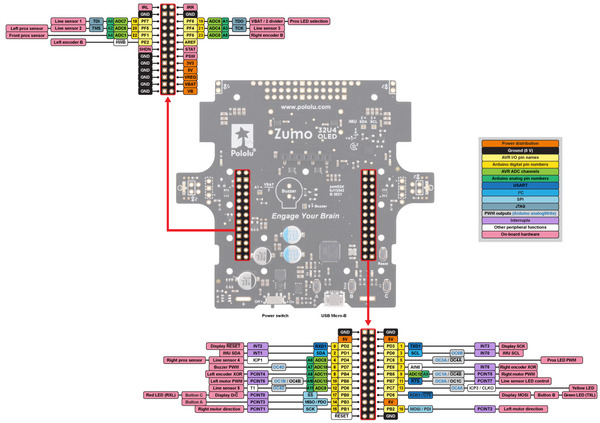 |
Zumo 32U4 OLED top expansion pinout. |
|---|
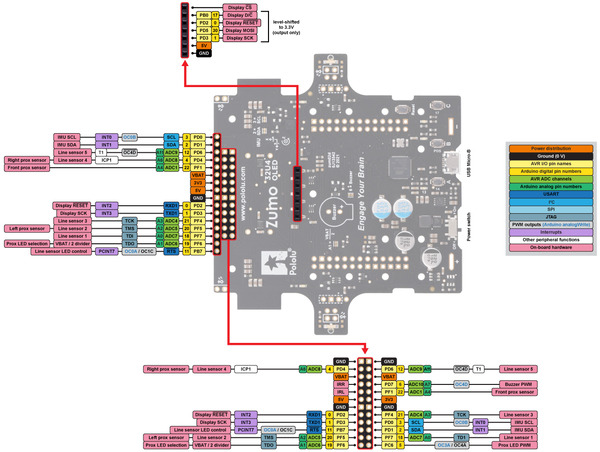 |
Zumo 32U4 OLED front expansion and display connector pinout. |
|---|
For more information about the ATmega32U4 microcontroller and its peripherals, see Atmel’s ATmega32U4 documentation.
3.10. Pin assignments
The table below lists the most important pin assignments for the ATmega32U4 on the Zumo 32U4. This table is helpful if you want to add your own electronics to the Zumo 32U4, write your own low-level code for interfacing with the hardware, or just want to understand better how the Zumo 32U4 works. Each row represents a physical pin on the ATmega32U4.
The “ATmega32U4 pin name” column shows the official name of the pin according to the ATmega32U4 datasheet.
The “Arduino pin names” column lists the names provided by the Arduino environment for the pin. These names can generally be used as arguments to any function that takes a pin number. However, there are some exceptions. For example, passing the number 4 to analogRead actually reads pin A4, not pin 4. Also, due to hardware limitations, some functions only work on a limited set of pins.
The “Zumo 32U4 functions” column documents what the pin is used for on the Zumo 32U4. Many pins can serve multiple purposes concurrently by switching modes. For example, PB0 can read the state of button C when it is an input, and it can control the red LED and serve as a display data line when it is an output.
The “Note/alternate functions” column documents other features of the pin, although some of those features might be impractical to use.
| ATmega32U4 pin name | Arduino pin names | Zumo 32U4 functions | Notes/alternate functions |
|---|---|---|---|
| PB7 | 11 | Line sensor IR LED control |
Timer0 PWM output A (OC0A) Timer1 PWM output C (OC1C) UART flow control (RTS) Pin-change interrupt (PCINT7) |
| PF7 | A0, 18 | Line sensor 1 (leftmost) | Analog input (ADC7) JTAG test data in (TDI) |
| PF5 | A2, 20 | Line sensor 2 Left proximity sensor (function selected by jumper) |
Analog input (ADC5) JTAG test mode select (TMS) |
| PF4 | A3, 21 | Line sensor 3 (center) | Analog input (ADC4) JTAG test clock (TCK) |
| PD4 | 4, A6, 24 | Line sensor 4 Right proximity sensor output (function selected by jumper) |
Analog input (ADC8) Timer1 input capture pin (ICP1) |
| PD6 | 12, A11, 29 | Line sensor 5 (rightmost) | Analog input (ADC9) Timer4 PWM output D (OC4D) Timer1 counter source (T1) |
| PF1 | A4, 22 | Front proximity sensor | Analog input (ADC1) |
| PC6 | 5 | Proximity LED PWM | Timer3 PWM output A (OC3A) Timer4 PWM output A (OC4A) |
| PF6 | A1, 19 | Proximity LED selection Battery level input (VBAT/2) | Analog input (ADC6) JTAG test data out (TDO) |
| PD2 | 0 | OLED version: Display reset (RESET) LCD version: LCD control line (RS) | UART receive pin (RXD1) External interrupt source (INT2) |
| PD3 | 1 | OLED version: Display SPI clock (SCK) LCD version: LCD control line (E) | UART transmit pin (TXD1) External interrupt source (INT3) |
| PB3 | 14, MISO | User pushbutton A LCD version: LCD data line DB4 | SPI Master Input/Slave Output (MISO) Pin-change interrupt (PCINT3) |
| PB0 | 17, SS | Red LED (RX) User pushbutton C OLED version: Display data/command select (D/C) LCD version: LCD data line DB5 | SPI slave select (SS) Pin-change interrupt (PCINT0) |
| PC7 | 13 | Yellow LED LCD version: LCD data line DB6 | Timer4 PWM output A (OC4A) Timer3 input capture pin (ICP3) Divided system clock output (CLKO) |
| PD5 | - | Green LED (TX) User pushbutton B OLED version: Display data (MOSI) LCD version: LCD data line DB7 | UART external clock (XCK1) UART flow control (CTS) |
| PD7 | 6, A7, 25 | Buzzer PWM | Analog input (ADC10) Timer4 PWM output D (OC4D) Timer0 counter source (T0) |
| PB6 | 10, A10, 28 | Left motor PWM | Analog input (ADC13) Timer1 PWM output B (OC1B) Timer4 PWM output B (OC4B) Pin-change interrupt (PCINT6) |
| PB2 | 16, MOSI | Left motor direction | SPI Master Output/Slave Input (MOSI) Pin-change interrupt (PCINT2) |
| PB5 | 9, A9, 27 | Right motor PWM | Analog input (ADC12) Timer1 PWM output A (OC1A) Timer4 PWM output B (OC4B) Pin-change interrupt (PCINT5) |
| PB1 | 15, SCK | Right motor direction | SPI Clock (SCK) Pin-change interrupt (PCINT1) |
| PB4 | 8, A8, 26 | Left encoder XORed input | Analog input (ADC11) Pin-change interrupt (PCINT4) |
| PE2 | - | Left encoder input | Hardware bootloader select (HWB) |
| PE6 | 7 | Right encoder XORed input | Analog comparator negative input (AIN0) External interrupt source (INT6) |
| PF0 | A5, 23 | Right encoder input | Analog input (ADC0) |
| PD0 | 3, SCL | I²C clock for inertial sensors | Timer0 PWM output B (OC0B) External interrupt source (INT0) |
| PD1 | 2, SDA | I²C data for inertial sensors | External interrupt source (INT1) |
| RESET | - | Reset pushbutton | internally pulled high, active low |
| AREF | - | - | Analog reference |
3.11. Adding electronics
This section gives tips for how the Zumo 32U4 can be expanded with additional electronics.
Freeing up I/O pins
If you want your additional electronics to send or receive information from the AVR, you will need to connect them to one or more of the AVR’s I/O pins. Each I/O pin is already being used for some other purpose, as documented in Section 3.10, so you might need to disable or disconnect one of the other features of the Zumo 32U4.
If you are not using the proximity sensors and you do not care about turning off the infrared emitters for the line sensors, you can cut the surface-mount jumper on the front sensor array labeled “LED”. This frees pin 11 (PB7) for other uses. Pin 11 can be used for digital I/O and analog input. We do not recommend making this change if you are using the proximity sensors, because then the line sensor infrared emitters would always be on, which would interfere with the proximity sensors.
If you are not using line sensor 2 or the left proximity sensor, then you can remove the sensor-selection jumper for pin 20 on the front sensor array. This frees up pin 20 (PF5) for other purposes. This pin can be used for digital input and output, as well as analog input.
If you are not using line sensor 4 or the right proximity sensor, then you can remove the sensor-selection jumper for pin 4 on the front sensor array. This frees up pin 4 (PD4) for other purposes. This pin can be used for digital input and output, as well as analog input.
If you are not using any of the sensors on the front sensor array, you can remove the front sensor array. This frees up 7 pins: pin 11 (PB7), pin 18 (PF7), pin 20 (PF5), pin 21 (PF4), pin 4 (PD4), pin 12 (PD6), and pin 22 (PF1). Each pin can be used for digital input and output, while 6 of them (all except pin 11) can be used as analog inputs.
If you are not using the proximity sensors, you probably will not want to use the IR LEDs on the main board, so that frees up pin 5 (PC6), which can be used for digital I/O or PWM output. That also frees up Timer3.
If you are not using the proximity sensors and you also do not need the AVR to be able to measure the battery voltage, you can use pin 19 (A1, PF6) for other purposes. This pin can be used for digital input and output, as well as analog input. If you want to use this pin as a digital or analog input, you might need to cut the surface-mount jumper labeled “A1 = VBAT / 2” in order to disconnect it from the VBAT voltage divider. If you only want to use A1 as an output, you might not need to cut that jumper.
If you do not need the display, you can remove it. This frees up pin 0 (PD2) and pin 1 (PD3). These pins are the transmit (TX) and receive (RX) pins of the UART, so you can use them to establish serial communication with another microcontroller. These pins are also capable of digital I/O. These pins are the recommended pins for connecting two output channels from an RC receiver, or for controlling two RC servos, because they are arranged in a convenient way with respect to power and ground on the right-side expansion header.
On the original (LCD) version of the Zumo 32U4, if you have removed the LCD and do not need to use button A, this frees up pin 14 (PB3). Pin 14 is capable of digital input and output. Removing the LCD also frees up the LCD contrast potentiometer for other purposes. The output of the potentiometer is a 0 V to 5 V signal which is accessible on the LCD connector. It can be connected to any free analog input if you want to read it from the AVR, or it might be useful to connect it to the other electronics that you are adding.
If you do not need to use the buzzer, you can cut the surface-mount jumper labeled “6 = Buzzer”. This disconnects pin 6 (PD7) from the buzzer, so it can be used for other things. Pin 6 (PD7) can be used as a PWM output, digital I/O line, or analog input. Disabling the buzzer also frees up Timer4, which has several PWM output pins. These pins can be used as PWM outputs if they are not needed for their normal tasks.
Be careful about connecting electronics to pin 13 (PC7), pin 17 (PB0), and PD5. These pins are used to control the LEDs on the Zumo 32U4. All three of these pins are controlled as outputs by the bootloader. Pin 17 (PB0) and PD5 are used as RX and TX indicators, so if you are sending or receiving data over USB then the Arduino USB code will drive those pins in its interrupt service routines while your sketch is running.
It should be possible to attach additional I²C slave devices to the Zumo 32U4’s I²C bus without giving up any features as long as the additional devices’ slave addresses do not conflict with those of the inertial sensors. (The sensors’ addresses are specified in their respective datasheets, which can be found in Section 3.7). The I²C pins (pins 2 and 3) operate at 5 V, so level shifters might be necessary to interface with other devices that use different voltages. (The level-shifted 3.3 V signals used by the inertial sensors are not available to the user.)
If you do not want to use the inertial sensors on the Zumo 32U4’s I²C bus, you can cut the surface-mount jumpers labeled “2 = SDA” and “3 = SCL”. This frees up pin 2 (PD1) and pin 3 (PD0). These pins can be used as digital inputs and outputs.
Power
All of the Zumo’s power nodes are accessible from the left expansion area. If you power additional devices from VBAT, then they will be powered whenever the Zumo’s power switch is in the ON position, and they will receive whatever voltage the batteries are outputting. If you power them from VREG, they will get 5 V power whenever the batteries are installed and the power switch is on (but they cannot be powered from USB). If you power them from the 5V pin, then they will receive 5V power whenever the Zumo 32U4 logic components are powered. If you power them from 3V3, they will receive 3.3V power whenever the Zumo 32U4 logic components are powered. For more information about these power nodes and how much current they can provide, see Section 3.8.
It is also possible to add your own power switch to control power to the Zumo, as described in Section 3.8.
Ground
You should make sure that all the grounds in your system are connected. The Zumo 32U4’s ground node is labeled “GND” and can be accessed from any of the expansion areas. It should be connected to the ground node of every other circuit board or device you add to the robot.
Making the physical connections
You should refer to Section 3.9 to locate the access points in the Zumo 32U4 expansion areas for the pins you have chosen. One option to make the connections to those pins is to get two 2×13-pin female headers and solder them in to the left and right expansion areas. Another option would be to break off pieces of a 2×40-pin male header and solder them in. Our premium jumper wires can then be plugged into the male or female headers.
3.11.1. Controlling a servo
It is possible to modify the Servo library that comes with the Arduino IDE to use Timer 3 instead of Timer 1 with an ATmega32U4 based controller like the Zumo 32U4. The modified Servo library does not interfere with Zumo32U4Motors, making it possible to simultaneously control servos and the motors.
Warning: The modifications described here will affect any sketch for an ATmega32U4 based controller that uses the Servo library, including the Arduino Leonardo or A-Star.
- First, you will need to locate the Arduino IDE’s Servo library, and find the file inside it named ServoTimers.h. For the 1.6.x versions of the IDE, this file can be found in libraries/Servo/src/avr/ServoTimers.h. If you are using Mac OS X, you will need to right-click on the Arduino IDE icon and select “Show Package Contents” to see the files inside.
- Open ServoTimers.h in a text editor.
- Locate the following lines of code in ServoTimers.h:
#elif defined(__AVR_ATmega32U4__) #define _useTimer1 typedef enum { _timer1, _Nbr_16timers } timer16_Sequence_t ; - The lower two lines of code specify that the library should use Timer 1. To use Timer 3 instead, just change
_useTimer1to_useTimer3and_timer1to_timer3. - Save the file.
The Arduino IDE will automatically incorporate your modifications to the Servo library. The next time you compile a sketch for an ATmega32U4 based controller that uses the Servo library, it will use Timer 3 instead of Timer 1.
3.12. AVR timers
The ATmega32U4 has 4 timers: Timer0, Timer1, Timer3, and Timer4. Each timer has a different set of features, as documented in the datasheet.
- Timer0 is used by the Arduino environment for timing-related functions like
millis(). - Timer1 is used by the Zumo 32U4 Arduino library for driving motors.
- Timer3 is used by the Zumo 32U4 Arduino library for emitting 38 kHz IR pulses for the proximity sensors, but it can be used for other purposes between readings of the sensors.
- Timer4 is used by the Zumo 32U4 Arduino library for controlling the buzzer. The buzzer pin (digital pin 6, or PD7; Timer4 output OC4D) can be freed for other uses by cutting the surface-mount jumper labeled “6 = Buzzer”.
3.13. Schematics and dimensions
Schematics
The schematic diagram for the Zumo 32U4 robot is available as a PDF:
- Zumo 32U4 OLED schematic diagram (408k pdf)
- Zumo 32U4 schematic diagram (419k pdf) (original LCD version)
Dimensions
A basic dimension diagram for the Zumo 32U4 Main Board is available as a PDF:
- Zumo 32U4 OLED Main Board dimension diagram (572k pdf)
- Zumo 32U4 Main Board dimension diagram (1MB pdf) (original LCD version)
Dimensions that are not included in the above diagram can be measured from the following DXF drawings:
- Zumo 32U4 OLED Main Board drill guide (200k dxf)
- Zumo 32U4 Main Board drill guide (239k dxf) (original LCD version)
3D models of the Zumo 32U4 Main Board and robot are also available in STEP format:
- Zumo 32U4 OLED Main Board 3D model (24MB step)
- Zumo 32U4 OLED robot 3D model (44MB step)
- Note: This model uses simplified models of the control electronics to reduce the file size.
- Zumo 32U4 Main Board v1.1 3D model (25MB step) (original LCD version)
- Zumo 32U4 robot 3D model (43MB step) (original LCD version)
- Note: This model uses simplified models of the control electronics to reduce the file size.
The following pictures show the approximate dimensions of the Zumo chassis used by the Zumo 32U4 robot:
|
|
4. Assembling the Zumo 32U4 kit
See Section 1.1 for a diagram to help you identify the contents of the Zumo 32U4 robot kit.
Please follow these instructions carefully to assemble your Zumo 32U4 robot kit properly. If you have an assembled version of the Zumo 32U4 robot, you can skip to Section 5 and start programming it!
Main board additions
Most of the hardware on the Zumo 32U4 main board consists of surface-mount components that are already soldered to the board, but there are a few through-hole parts that you need to solder yourself.
- Solder the buzzer to the top of the main board, matching its orientation to the printed outline, then trim the excess length from the buzzer leads underneath the board.
- Solder the two 1×2 machine pin sockets to the top of the board in the front corners.
- Optional: If you plan to connect headers or wires to the top expansion area, consider soldering them now.
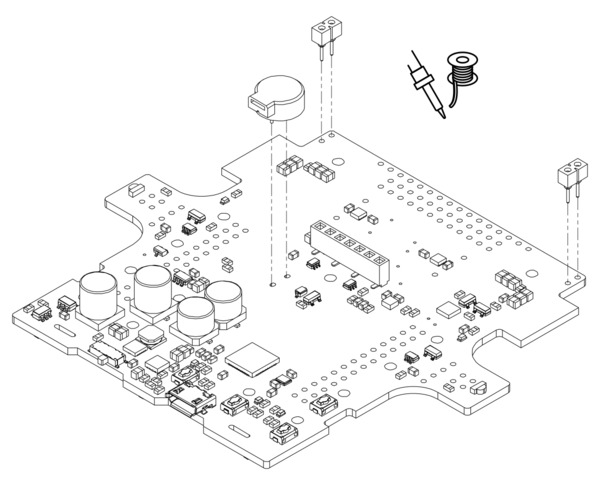 |
While it is still possible to solder all of these parts after the main board has been mounted on the chassis, soldering them beforehand is easier and avoids the risk of inadvertently melting the chassis with your soldering iron.
Motors
If you have an older Zumo 32U4 kit with white sprockets (which we shipped before May 2015), you should skip step 4 and install the drive sprockets after step 14 instead, at the same time as the idler sprockets. (If the white drive sprockets were attached now, their shape would make the motors, chassis, and main board difficult to assemble.)
- Press the output shafts of the motors into the drive sprockets, with the raised lip on one side of the sprocket facing away from the motor. The end of the gearbox shaft should end up flush with the outside of the sprocket. A good way to do this is to set the wheel on flat surface (like a table top) and press the motor shaft into the wheel until it contacts the surface.
 |
- Cut two of the included jumper wires in half to form four segments, and trim off the ends that are covered in adhesive (the adhesive could interfere with making a good electrical connection to the motor). These wire segments will be used as motor leads.
- Solder a pair of leads to each motor, paying attention to the way the motor will eventually be oriented in the chassis (see below). You might find it helpful to make a small bend at the tip of each lead to hook into the hole in the motor lead tab to hold it in place for soldering.
Warning: Holding the soldering iron against the motor lead for more than a few seconds can start to damage the motor brushes, so try to be reasonably quick/efficient with this soldering. If the first attempt does not go well, remove the soldering iron and let the motor cool for a few seconds before trying again.
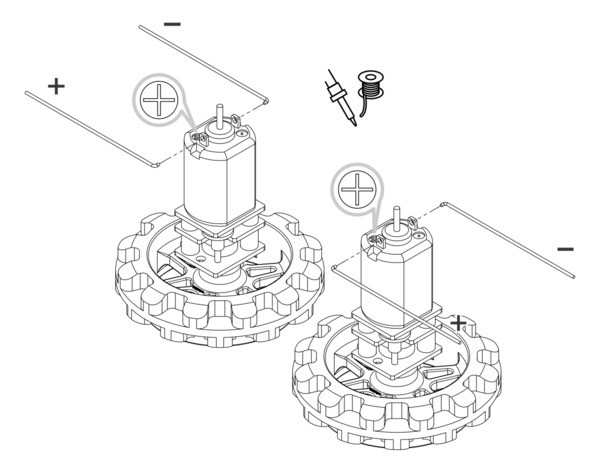 |
Each motor’s positive terminal is indicated by a plus sign (+) in the black plastic end of the motor. If you are using one of our recommended micro metal gearmotors (50:1, 75:1, or 100:1) or any lower gear ratio, the motors should be soldered into the main board with the positive terminal closest to the front, so you should attach the leads to allow the motors to be oriented this way. However, if you are using a motor with a 150:1 or higher gear ratio, you should reverse the motor orientation so the positive terminals are facing the rear. (Don’t worry if you accidentally get the orientation of one or both motors wrong, though. You can later correct for it in software with our Zumo32U4 library.)
- Press a magnetic encoder disc onto the motor shaft of each motor so that the end of the shaft is flush with the back of the disc. One easy way to accomplish this is to press the motor onto the disc while the disc is sitting on a flat surface, pushing until the shaft makes contact with that surface.
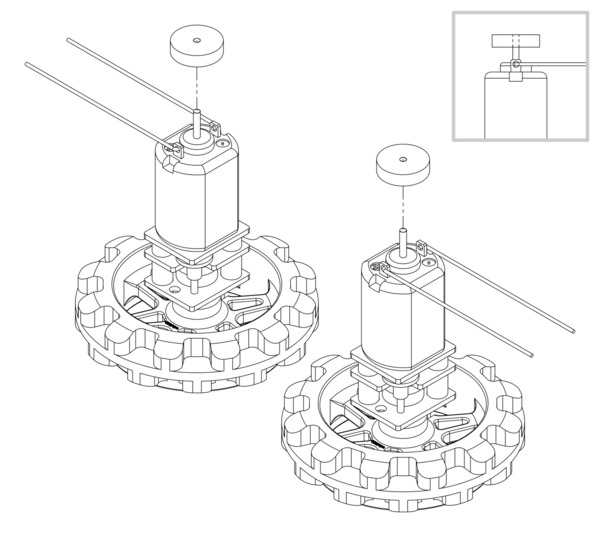 |
Chassis
- Place the motors into the channel in the front of the chassis, aligning the gearbox with the grooves in the channel. The outer plate of the gearbox should be even with the edge of the chassis.
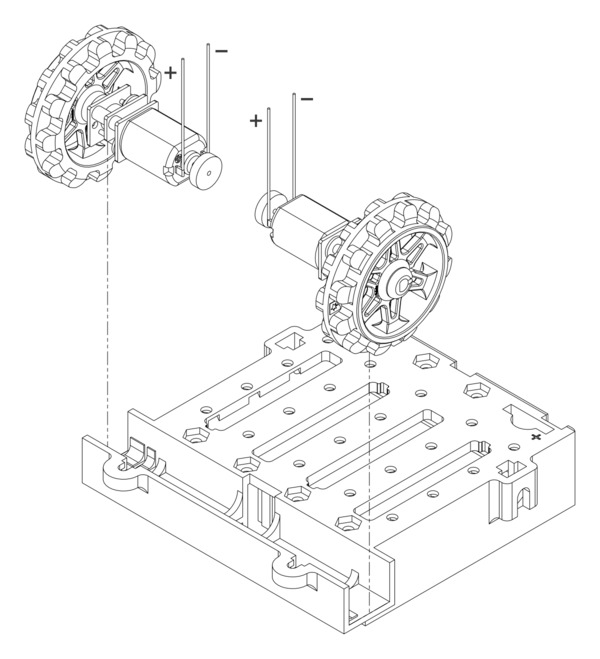 |
- Cover the chassis and motors with the main board. The motor leads should be inserted into the through holes next to the motor drivers.
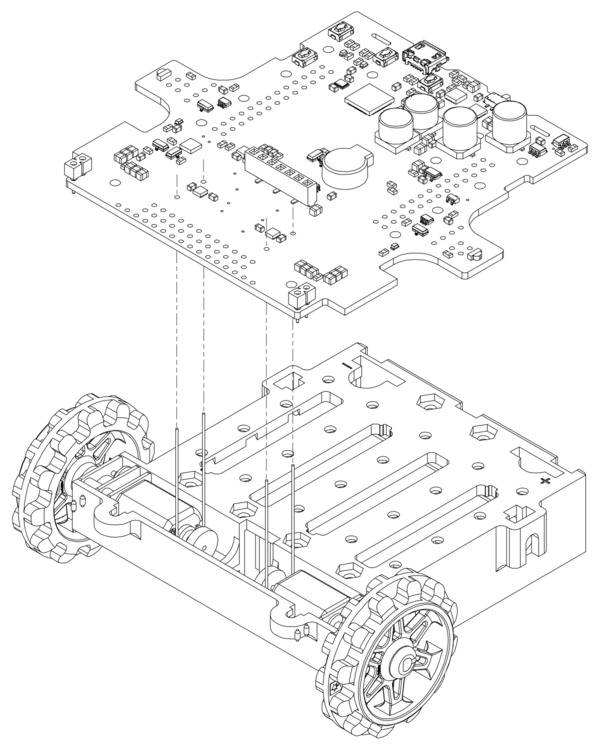 |
- Screw the main board to the chassis: we recommend using four screws in the holes closest to the corners of the board. In each of the four mounting holes, insert a #2-56 machine screw through the main board and chassis, and tighten it against a nut under the chassis. It is usually easier to place the nut into the recess first and hold it there with a finger or piece of tape while inserting the screw.
 |
Note that the kit includes two different sizes of #2-56 machine screws: 3/16″ and 1/4″. The two longer screws are intended for use in the front holes (near the motors) so that the additional thickness of a sumo blade can be accommodated. While you can add the blade before screwing the robot together for the first time, we suggest waiting until after you have soldered in the 2×12 connector for the front sensor array so that you have more room to work.
- Solder each motor lead to the main board, then trim off the excess length of wire.
 |
- Solder the 2×12 female header (front sensor array connector) to the bottom of the front expansion area on the main board. It should be flush with the chassis.
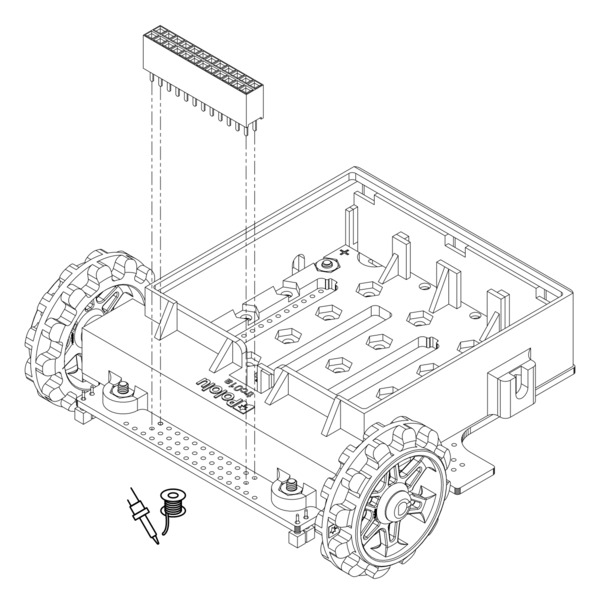 |
Battery contacts
- Turn the chassis over and install the battery terminal contacts as shown in the pictures below. The three double-contact pieces should be firmly pressed into place until they are flush with the interior surface of the battery compartment.
Note: there are two different kinds of double-sided battery contacts, one with the spring on the left and one with the spring on the right, and they must be installed in the correct locations to make proper contact with the batteries.
 |
The two individual contacts should be inserted into the battery compartment so that their solder tabs protrude through the holes in the top of the chassis; you might want to temporarily tape or clamp these two individual contacts in place until they have been soldered to the main board as described in the next step, or you can use a battery to temporarily hold them in place.
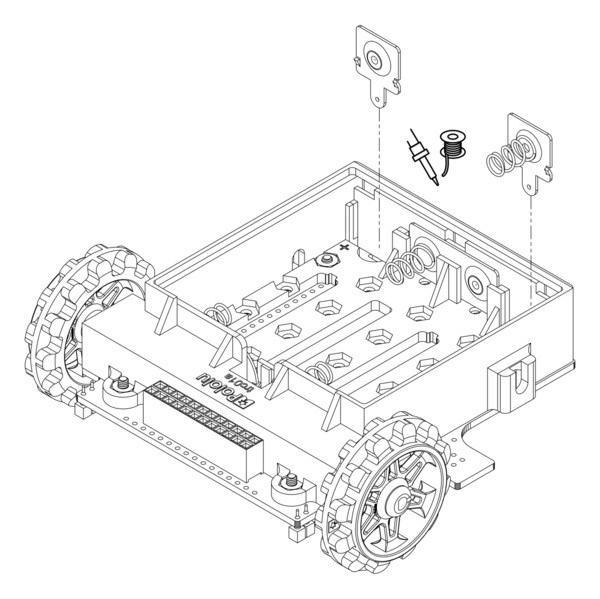 |
- Solder the two individual contacts to the main board from the top. Note that if you are using a battery to hold the contact in place during soldering, the battery might act as a heat sink, making it more difficult to solder or requiring a higher soldering iron temperature. The battery terminal slot in the PCB should be completely filled with solder.
Idler sprockets and tracks
- Place an M3 nut in each of the two side slots near the rear of the chassis. The slots are sized so that nuts will not be able to rotate within them.
- Place an idler sprocket on each shoulder bolt, followed by a washer. The protruding side of the sprocket hub should face the same direction as the threaded end of the bolt (in toward the chassis).
- Insert the shoulder bolts through the side of the chassis into the nut. Use a 3 mm hex key (Allen wrench) to tighten the bolts until the washers are snug against the chassis. Be careful not to overtighten the shoulder bolts as doing so can bend the washers. Note: Be careful if you use threadlocking adhesives like Loctite as these can corrode the chassis. You should first test any such adhesives on a concealed part of the chassis to ensure they will not damage it.
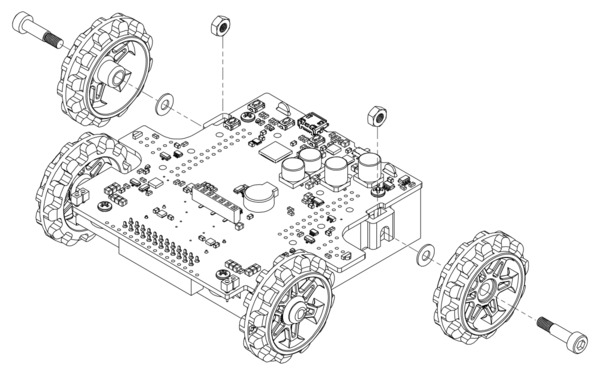 |
- Install the silicone tracks by stretching them around the sprockets on each side of the chassis.
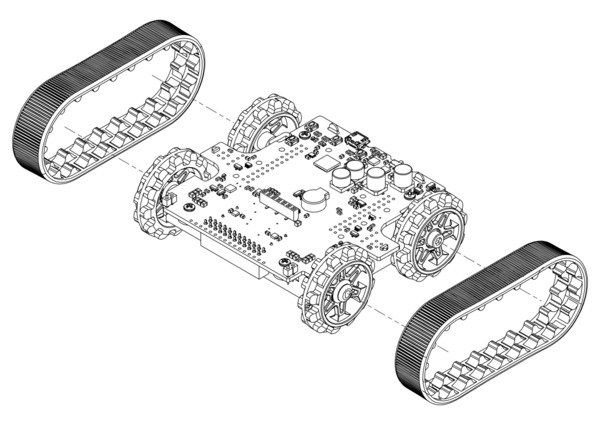 |
Blade
- If necessary, bend the blade’s mounting tabs to the appropriate angle (about 75 degrees from flat).
- Remove the two 1/4″ screws attaching the front of the main board to the chassis.
- Place the blade’s mounting tabs on top of the main board so that the holes line up with the two front mounting holes and the two screws through the blade, main board, and chassis. Replace the nuts underneath the chassis and tighten the screws.
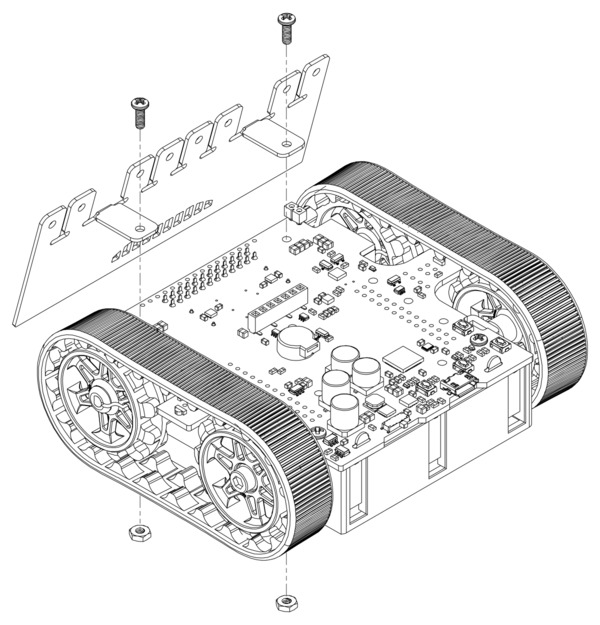 |
Display
- Solder the 1×7 low-profile header to the OLED display (or the 2×7 low-profile header to the LCD). The shorter side of the header should be inserted fully through the corresponding through holes from the bottom side of the display module until the header is flush, and the solder joints should be made on the top (screen) side of the display. Tip: Solder a single pin first and ensure the header is flush before making any additional solder joints. If the header is not flush, you can use the soldering iron to re-melt the solder joint while you make the necessary adjustments. Be careful not to touch the pin you are soldering as the heat will conduct all the way through to the other end!
|
|
- On the Zumo 32U4 OLED version, you can optionally install a #2-56 standoff to help support the OLED display. Tighten the standoff against a nut under the chassis.
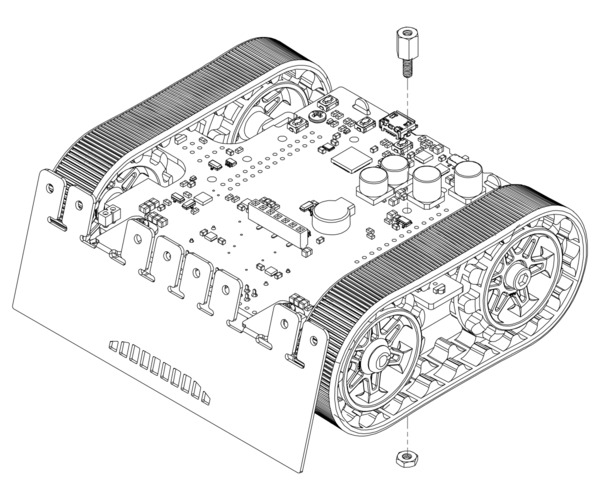 |
- Plug the display into the matching female header on top of the main board; the display should cover the buzzer. You can optionally use one more 3/16″ #2-56 screw to secure the OLED display to the standoff.
Warning: The display header does not enforce proper orientation, so it is possible to plug the display in offset or rotated 180° from its intended position. Incorrect positioning can damage the display or the main board, so please take care during this step to ensure that the display is plugged in properly.
|
|
Front sensor array
- Solder the two 1×3 right-angle male headers on top of the sensor array board. These should go in the two sets of three holes in the rear corners of the board, and the pins should face inward. Note: these pins go on the side of the board without components.
- Solder the 2×12 extended male header to the top of the sensor array. Note: these pins also go on the side of the board without components, so that the sensors point at the ground when the board is plugged into the Zumo; if you solder this header on the wrong side, the sensor array will not work!
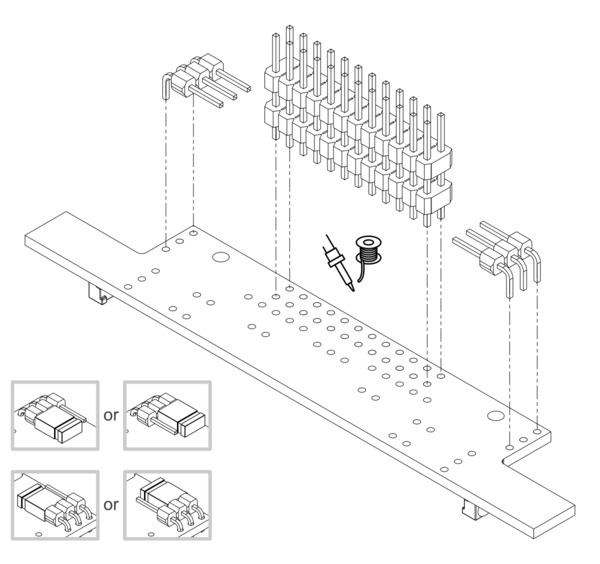 |
- On each 1×3 header, install a shorting block to connect the sensor of your choice. (See Section 3.5 for details.)
- Plug the sensor array into the matching female header on the bottom of the main board.
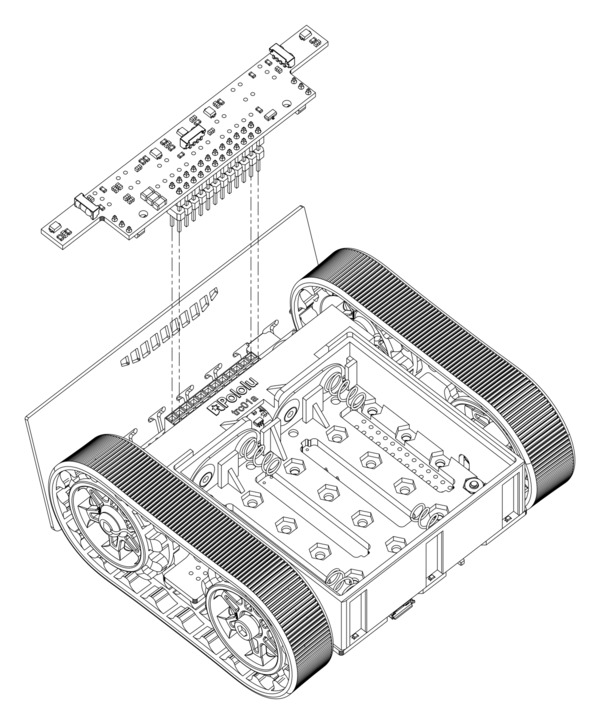 |
Forward emitters
- Choose a pair of through-hole infrared LEDs to use as the forward emitters. (See Section 3.6 for details about the different LEDs included with the Zumo 32U4.)
The forward IR emitter LEDs can be installed using the plastic LED holder, which we recommend using in most cases (continue to step 30). Alternatively, they can be installed without the LED holder using heat shrink tubing as shrouds; this mounts them less securely, but allows some more flexibility in their positioning (skip to step 35).
Note: Kits shipped before August 2015 do not include the LED holder and its mounting screws.
- Insert the LEDs into the rear of the LED holder, making sure that each LED’s anode (the longer lead that ends in the smaller post inside the case of the LED) is on the bottom.
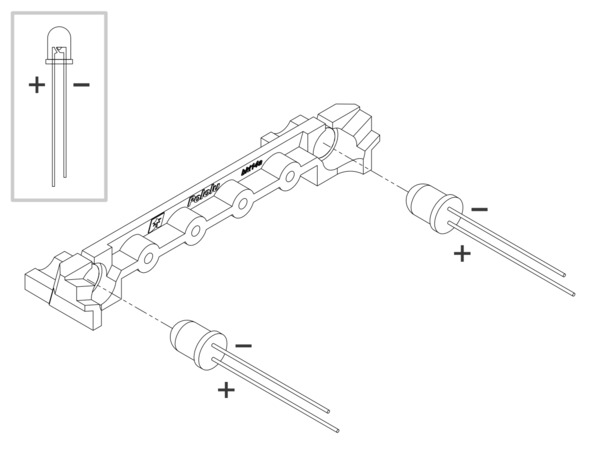 |
- Bend the LED leads outward so they rest along the channels in the LED holder, then downward around the sides of the holder. Using a pair of long-nose pliers can help you make more precise bends.
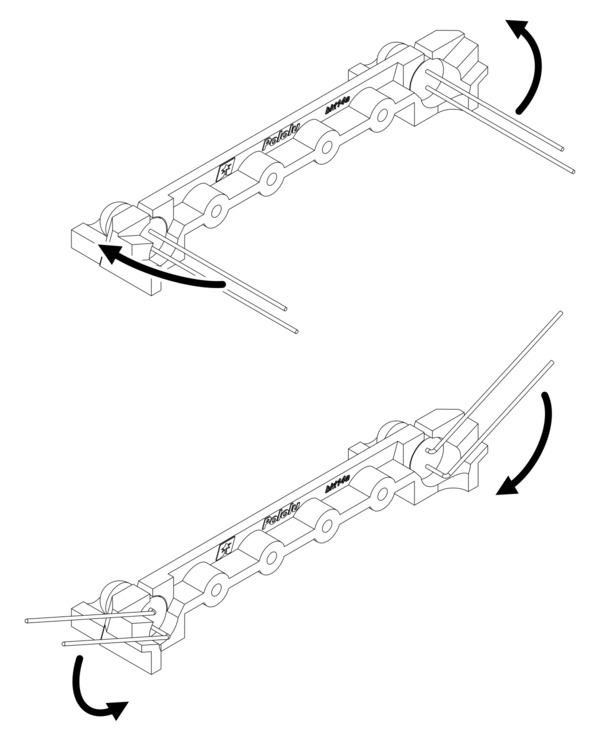 |
- Trim the LED leads so that they extend slightly below the bottom of the LED holder.
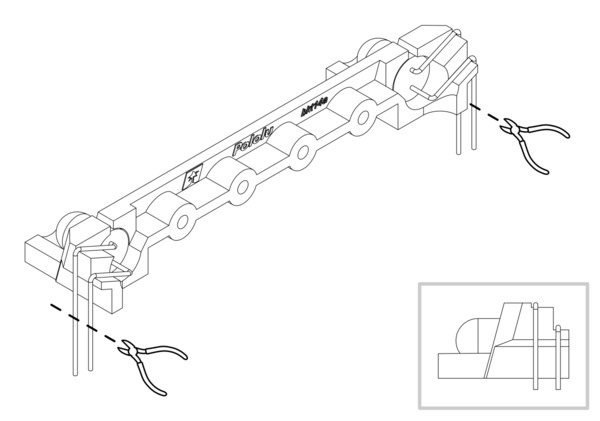 |
- Install the LED holder behind the blade by inserting the LED leads into the machine pin sockets in the front of the main board.
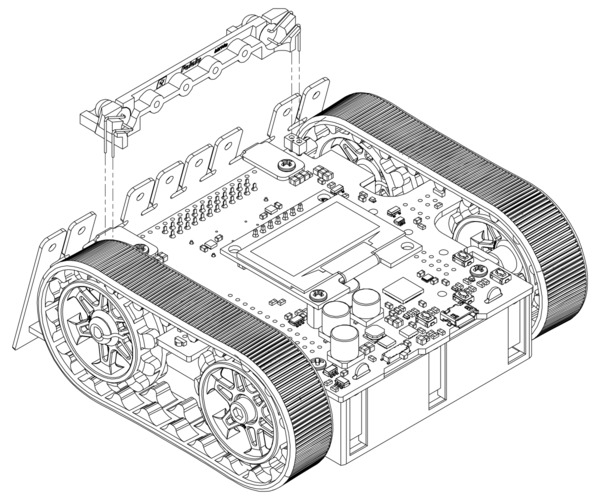 |
- Use two 3/16″ #2-28 thread-forming screws to fasten the LED holder to the blade. Note that the screw heads will not be completely flush against the blade when properly tightened; to avoid damaging the LED holder, do not overtighten the screws!
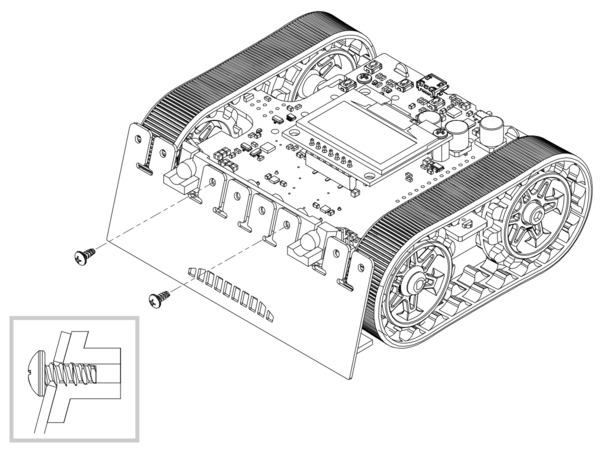 |
To finish assembly after installing the forward emitters with the LED holder, skip to step 40.
Forward emitters – alternate method (without LED holder)
- Use a pair of long-nose pliers to bend the LED leads to approximately match the shapes pictured, making sure that each LED’s anode (the longer lead that ends in the smaller post inside the case of the LED) is toward the rear.
- Trim the excess length from the leads and insert the LEDs into the machine pin sockets in the front of the main board.
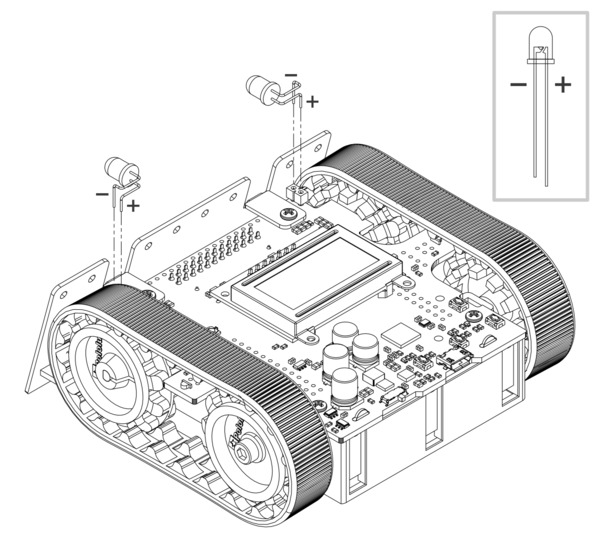 |
- Cut a length of heat shrink tubing about 3/4″ (19 mm) long. 3/16″ diameter heat shrink tubing can work well (we included tubing of this size with kits prior to August 2015), but please note that the actual diameter of heat shrink tubing often differs significantly from its nominal diameter, depending on the type and manufacturer of the tubing.
- Flatten the tube and make a diagonal cut through it to produce two equal pieces. Each piece should measure about 1/2″ (13 mm) along the longer side.
- Slip one of these pieces of heat shrink tubing, square end first, over each forward emitter LED so that it extends past the case of the LED. The diagonal opening of each tube should face forward and upward so that the longer side of the shroud blocks infrared light from hitting the floor.
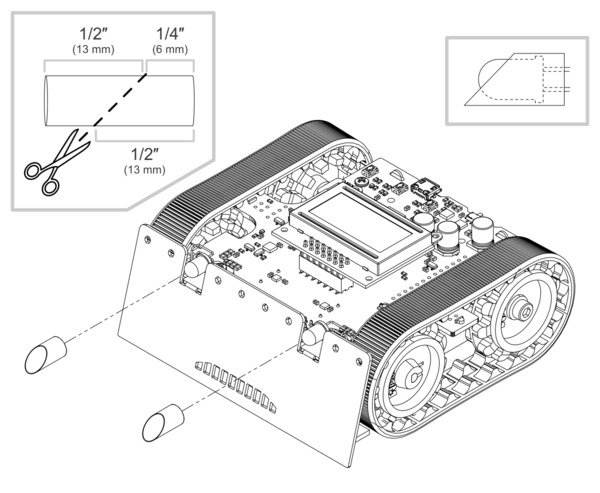 |
Batteries
- Install four new or freshly charged AA batteries in the battery compartment. (We recommend using rechargeable AA NiMH cells.)
- Replace the battery compartment cover.
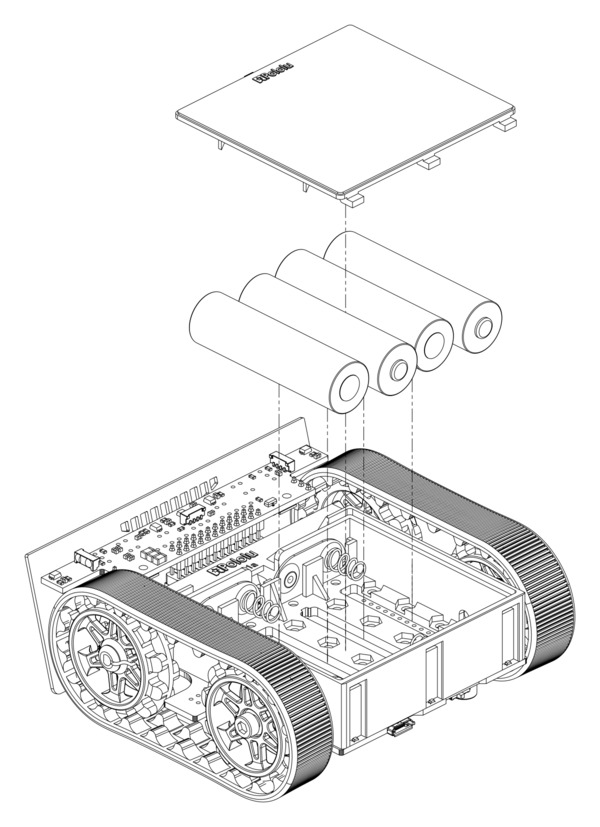 |
The assembly of your Zumo 32U4 robot is now complete, and it is ready to be programmed and run!
 |
5. Programming the Zumo 32U4
The Zumo 32U4 is designed to be programmed over USB from the Arduino IDE. It can be programmed from Windows, Linux, and macOS. The ATmega32U4 on the Zumo 32U4 comes preloaded with the same USB bootloader as the A-Star 32U4 family of general-purpose programmable ATmega32U4 boards. The following sections will help you get started programming your Zumo 32U4.
5.1. Installing Windows drivers
If you use Windows XP, you will need to have either Service Pack 3 or Hotfix KB918365 installed before installing the A-Star drivers. Some users who installed the hotfix have reported problems that were solved by upgrading to Service Pack 3, so we recommend Service Pack 3 over the hotfix.
If you use Windows on an Arm-based PC, Windows will refuse to install these drivers due to different requirements for digital signatures. You should be able to skip this section and still use the device.
Before you connect your Pololu A-Star 32U4 (or another of our 32U4 family of boards) to a computer running Microsoft Windows, you should install its drivers:
- Download the A-Star Windows Drivers (7k zip) and extract the ZIP file to a temporary folder on your computer. (These files are also available in the “drivers” directory from the A-Star repository on GitHub.)
- Open the “a-star-windows” folder. Right-click on “a-star.inf” and select “Install”.
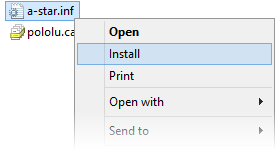 |
- Windows will ask you whether you want to install the drivers. Click “Install” (Windows 10, 8, 7, and Vista) or “Continue Anyway” (Windows XP).
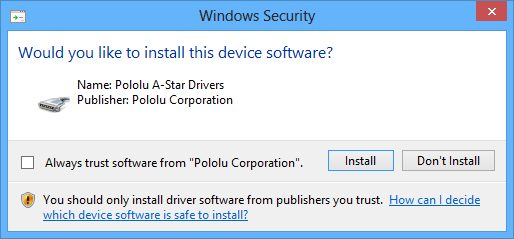 |
- Windows will not tell you when the installation is complete, but it should be done after a few seconds.
Windows 11, Windows 10, Windows 8, Windows 7, and Windows Vista users: After installing the drivers, your computer should automatically recognize the device when you connect it via USB. No further action from you is required. However, the first time you connect an A-Star device to your computer, Windows will take several seconds to recognize the device and configure itself properly. The first time you program the device, Windows will again take several seconds to recognize the A-Star USB bootloader, and this could cause the programming operation to fail the first time. Also, Windows will need to re-recognize the device and the bootloader if you connect the board to another USB port that it has not been connected to before.
Windows XP users: After installing the drivers, you will need to follow steps 5–9 for each new A-Star device you connect to your computer. You will also need to follow these steps the first time you attempt to program the device in order to make Windows recognize the bootloader, and when you connect the device to a different USB port that it has not been connected to before.
- Connect the device to your computer’s USB port.
- When the “Found New Hardware Wizard” is displayed, select “No, not this time” and click “Next”.
- On the second screen of the “Found New Hardware Wizard”, select “Install the software automatically” and click “Next”.
- Windows XP will warn you again that the driver has not been tested by Microsoft and recommend that you stop the installation. Click “Continue Anyway”.
- When you have finished the “Found New Hardware Wizard”, click “Finish”.
COM port details
After installing the drivers and plugging in an A-Star, in the “Ports (COM & LPT)” category of the Device Manager, you should see a COM port for the A-Star’s running sketch named “Pololu A-Star 32U4”.
You might see that the COM port is named “USB Serial Device” in the Device Manager instead of having a descriptive name. This can happen if you are using Windows 10 or later and you plugged the A-Star into your computer before installing our drivers for it. In that case, Windows will set up your A-Star using the default Windows serial driver (usbser.inf), and it will display “USB Serial Device” as the name for the port. The port will still be usable, but it will be hard to tell if it is the right one because of the generic name shown in the Device Manager. We recommend fixing the names in the Device Manager by right-clicking on each “USB Serial Device” entry, selecting “Update Driver Software…”, and then selecting “Search automatically for updated driver software”. Windows should find the drivers you already installed, which contain the correct name for the port.
If you are using Windows 10 or later and choose not to install the drivers, the A-Star will still be usable. To tell which “USB Serial Device” in your Device Manager is the A-Star, double-click on each one and look at the “Hardware Ids” property in the “Details” tab. An A-Star running a sketch will have the ID USB\VID_1FFB&PID_2300&MI_00, while an A-Star in bootloader mode will have the ID USB\VID_1FFB&PID_0101.
If you want to change the COM port numbers assigned to your A-Star, you can do so using the Device Manager. Double-click a COM port to open its properties dialog, and click the “Advanced…” button in the “Port Settings” tab.
5.2. Programming using the Arduino IDE
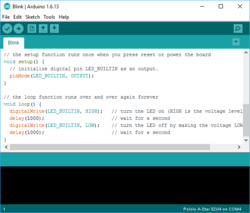 |
Programming the A-Star 32U4 from the Arduino IDE. |
|---|
Our 32U4 family of boards can be programmed from the popular Arduino integrated development environment (IDE). The Arduino IDE is a cross-platform, open source application that integrates a C++ code editor, the GNU C++ compiler, and a program upload utility. To get started programming your device with the Arduino IDE (version 1.6.4 or later), follow these steps:
- Download the Arduino IDE from the Arduino Download page, install it, and start it.
- In the Arduino IDE, open the File menu (Windows/Linux) or the Arduino menu (macOS) and select “Preferences”.
- In the Preferences dialog, find the “Additional Boards Manager URLs” text box (highlighted in the picture below). Copy and paste the following URL into this box:
https://files.pololu.com/arduino/package_pololu_index.json
If there are already other URLs in the box, you can either add this one separated by a comma or click the button next to the box to open an input dialog where you can add the URL on a new line.
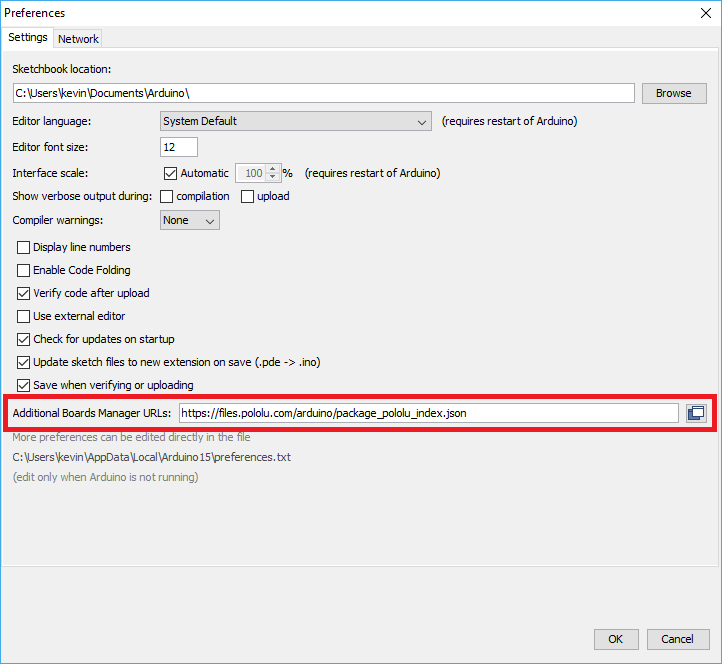 |
Adding a Boards Manager index for Pololu boards in the Arduino IDE’s Preferences dialog. |
|---|
- Click the “OK” button to close the Preferences dialog.
- In the Tools > Board menu, select “Boards Manager…” (at the top of the menu).
- In the Boards Manager dialog, search for “Pololu A-Star Boards”.
- Select the “Pololu A-Star Boards” entry in the list, and click the “Install” button.
- After the installation finishes, click the “Close” button to close the Boards Manager dialog.
- In the Tools > Board menu, select the “Pololu A-Star 32U4” entry. If you do not see your device listed in the Board menu, try restarting the Arduino IDE.
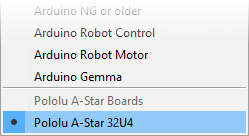 |
Selecting the Pololu A-Star 32U4 in the Boards menu. |
|---|
- In the Tools > Port menu, select the port for the device. On Windows you can determine what COM port the device is assigned to by looking at the “Ports (COM & LPT)” section of the Device Manager. On Linux, the port name will begin with “/dev/ttyACM”. On Mac OS X, the port name will begin with “/dev/tty.usbmodem”.
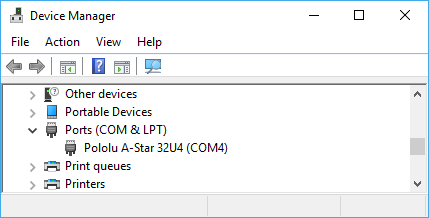 |
Windows 10 Device Manager showing the A-Star’s virtual COM port. |
|---|
- Open up the “Blink” Arduino example, which can be found under File > Examples > 01.Basics > Blink. The code in this example will blink the yellow LED. When you select the Blink example, a new Arduino IDE window will open up. It is OK to close the first window.
 |
Selecting the Blink example in the Arduino IDE. |
|---|
- Press the “Upload” button to compile the sketch and upload it to the device. If everything goes correctly, you will see the message “Done uploading” appear near the bottom of the window. If you are using Windows and you have not previously programmed an A-Star device on this USB port, then Windows might take several seconds to recognize the A-Star bootloader. The bootloader times out after 8 seconds and goes back to running the sketch, so the upload might fail if Windows does not recognize it quickly enough. If this happens, try again. If you are using Windows XP and have not programmed an A-Star on this USB port, you will have to go through the Found New Hardware Wizard again as described in the previous section, but the second time you try to upload it should work. If the Arduino IDE has trouble connecting to the port or using it, try unplugging the device, closing any programs that might be using the serial port, restarting the Arduino IDE, and then plugging the device back in.
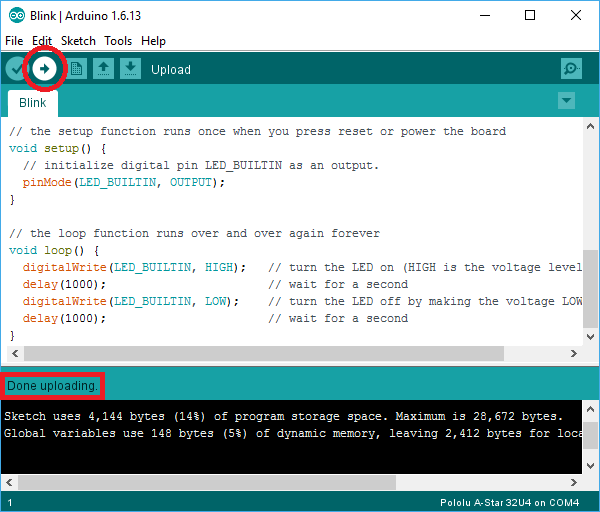 |
Uploading a sketch to the A-Star using the Arduino IDE. |
|---|
- If you uploaded the Blink sketch, then the yellow LED should be blinking once every two seconds. However, we ship some A-Stars with that same example already programmed onto it, so you might not be convinced that anything has changed. Try changing the delay values in the sketch to something else and uploading again to see if you can change the speed of the LED.
The A-Star 32U4 boards are similar enough to the Arduino Leonardo that you do not actually have to install the add-on. If you want to, you can just select the “Arduino Leonardo” board in the Arduino IDE. Note that if you upload a sketch to the device this way, your computer will then recognize it as a Leonardo (for example, its entry in the Windows Device Manager will display “Arduino Leonardo”).
After you succeed in programming your device from the Arduino IDE, there are many resources you can use to learn more:
- The Arduino IDE has many examples that can run on A-Stars.
- The Arduino website has a Language Reference, a wiki called the The Arduino Playground, and other resources.
- The A-Star 32U4 boards are similar to the Arduino Leonardo and Arduino Micro, so you can search the Internet for relevant projects that use one of those boards.
- The Related Resources section lists many more resources.
Disabling ModemManager in Linux
If you are using Linux and have trouble following the instructions above, your issue might be caused by a program called ModemManager. This program automatically connects to serial ports and sends modem commands to them, interfering with other software using those ports. You can run ps ax | grep -i Modem to see if ModemManager is running. On Ubuntu, the command to permanently disable ModemManager is:
sudo systemctl disable ModemManager
5.3. Programming using avr-gcc and AVRDUDE
This section explains how to program our 32U4 family of boards using the avr-gcc toolchain and AVRDUDE. This section is intended for advanced users who do not want to use the Arduino IDE as described in the previous section.
Getting the prerequisites
If you are using Windows, we recommend downloading WinAVR, which contains the avr-gcc toolchain and a command-line utility called AVRDUDE that can be used to upload programs to the A-Star bootloader. If the version of GNU Make that comes with WinAVR crashes on your computer, we recommend using the Pololu version of GNU Make.
If you are using macOS, we recommend first installing Homebrew. Then run the following commands to install AVRDUDE and homebrew-avr:
brew install avrdude xcode-select --install brew tap osx-cross/avr brew install avr-gcc
If you are using Linux, you will need to install avr-gcc, avr-libc, and AVRDUDE. Ubuntu users can get the required software by running:
sudo apt-get install gcc-avr avr-libc avrdude
After you have installed the prerequisites, open a command prompt and try running these commands to make sure all the required utilities are available:
avr-gcc -v avr-objcopy -V make -v avrdude
If any of those commands fail, make sure the desired executable is installed on your computer and make sure that it is in a directory listed in your PATH environment variable.
Compiling an example program
Copy the following code to a file named “main.c”:
#define F_CPU 16000000
#include <avr/io.h>
#include <util/delay.h>
int main()
{
DDRC |= (1 << DDC7); // Make pin 13 be an output.
while(1)
{
PORTC |= (1 << PORTC7); // Turn the LED on.
_delay_ms(500);
PORTC &= ~(1 << PORTC7); // Turn the LED off.
_delay_ms(500);
}
}
In the same folder, create a file named “Makefile” with the following contents:
PORT=\\\\.\\GLOBALROOT\\Device\\USBSER000 MCU=atmega32u4 CFLAGS=-g -Wall -mcall-prologues -mmcu=$(MCU) -Os LDFLAGS=-Wl,-gc-sections -Wl,-relax CC=avr-gcc TARGET=main OBJECT_FILES=main.o all: $(TARGET).hex clean: rm -f *.o *.hex *.obj *.hex %.hex: %.obj avr-objcopy -R .eeprom -O ihex $< $@ %.obj: $(OBJECT_FILES) $(CC) $(CFLAGS) $(OBJECT_FILES) $(LDFLAGS) -o $@ program: $(TARGET).hex avrdude -p $(MCU) -c avr109 -P $(PORT) -U flash:w:$(TARGET).hex
Make sure that the PORT variable in the Makefile is the name of the device’s virtual serial port. In Windows, \\\\.\\GLOBALROOT\\Device\\USBSER000 should work if the A-Star is the only USB device connected that is using the usbser.sys driver, but you can change it to be the actual name of the COM port (e.g. COM13).
In a command prompt, navigate to the directory with the Makefile and main.c. If you run the command make, the code should get compiled and produce a file named “main.hex”.
Programming
To program the A-Star device, you will need to get it into bootloader mode first. One way to do this is to reset the AVR twice within 750 ms. Most of the boards in our 32U4 family have a reset button that can be used to reset the board. On any of our 32U4 family of boards, a pushbutton can be connected between the GND and RST pins to serve as a reset button, or you can use a wire. Once the device is in bootloader mode, quickly run the command make program to program it. If you wait longer than 8 seconds, the A-Star bootloader will exit and the AVR will go back to running the user program.
6. Zumo 32U4 Arduino library
The Zumo 32U4 can be programmed from the Arduino IDE as described in the preceding sections.
To help interface with all the on-board hardware on the Zumo 32U4, we provide the Zumo32U4 library. The Zumo32U4 library documentation provides detailed information about the library, and the library comes with several example sketches.
Use the Library Manager in version 1.8.10 or later of the Arduino software (IDE) to install this library:
- In the Arduino IDE, open the “Sketch” menu, select “Include Library”, then “Manage Libraries…”.
- Search for “Zumo32U4”.
- Click the Zumo32U4 entry in the list.
- Click “Install”.
- If you see a prompt asking to install missing dependencies, click “Install all”.
After you install the Zumo32U4 library, you can learn more about it by trying the included example sketches and by reading the Zumo32U4 library documentation.
7. The Zumo 32U4 USB interface
Our 32U4 family of boards are based on a single ATmega32U4 AVR microcontroller that runs the user program and also handles the USB connection to the computer. The AVR has a full-speed USB transceiver built into it and can be programmed to present almost any type of USB device interface to the computer.
USB is an asymmetric system that consists of a single “host” connected to multiple “devices”. The host is typically a personal computer. The ATmega32U4 can only act as a USB device, so an A-Star device cannot be connected to other USB devices like mice and keyboards; it can only be connected to a host such as your computer.
Programming an ATmega32U4 board using the Arduino IDE as described earlier will automatically configure it as a composite device with a single virtual serial port. If you program the microcontroller with an Arduino sketch that implements another USB device class, like HID or MIDI, you will see additional child devices as well.
On a Windows computer, you can see the virtual serial port by going to your computer’s Device Manager and expanding the “Ports (COM & LPT)” list. You should see a COM port labeled “Pololu A-Star 32U4”. In parentheses after the name, you will see the name of the port (e.g. “COM3” or “COM4”). Windows will assign a different COM port number to the device depending on what USB port you plug it into and whether it is in bootloader mode or not. If you need to change the COM port number assigned to the A-Star, you can do so using the Device Manager. Double-click on the COM port to open its properties dialog, and click the “Advanced…” button in the “Port Settings” tab. From this dialog you can change the COM port assigned to the device.
 |
Windows 10 Device Manager showing the A-Star’s virtual COM port. |
|---|
On a Windows computer, you can see the rest of the USB interface by going to the Device Manager, selecting View > Devices by connection, and then expanding entries until you find the “Pololu A-Star 32U4” COM port. Near it, you should see the parent composite device.
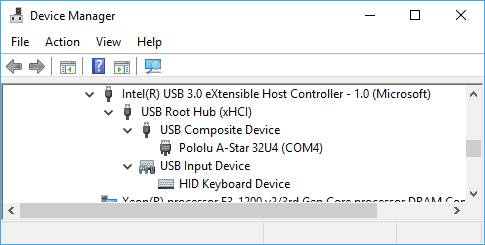 |
The Windows 10 Device Manager in “Devices by connection” mode, showing that the A-Star is a composite device. |
|---|
On a Linux computer, you can see details about the USB interface by running lsusb -v -d 1ffb: in a Terminal. The virtual serial port can be found by running ls /dev/ttyACM* in a Terminal.
On a Mac OS X computer, the virtual serial port can be found by running ls /dev/tty.usbmodem* in a Terminal.
You can send and receive bytes from the virtual serial port using any terminal program that supports serial ports. Some examples are the Serial Monitor in Arduino IDE, the Pololu Serial Transmitter Utility, Br@y Terminal, PuTTY, TeraTerm, Kermit, and GNU Screen. Many computer programming environments also support sending and receiving bytes from a serial port.
8. The A-Star 32U4 Bootloader
Our 32U4 family of boards come with a USB bootloader that can be used in conjunction with the Arduino IDE or AVRDUDE to load new programs onto the device. This section documents some technical details of the bootloader for advanced users who want to better understand how it works. If you just want to get started using your device, it is fine to skip this section.
The A-Star 32U4 Bootloader is based on the Caterina bootloader, which is the bootloader used on the Arduino Leonardo, Arduino Micro and several other ATmega32U4 boards. The bootloader is open source and its source code is available on GitHub. The bootloader occupies the upper four kilobytes of the ATmega32U4’s program memory, leaving 28 KB for the user program. The bootloader’s USB interface consists of a single virtual serial port that accepts the programming commands defined in AVR109. The bootloader always runs first immediately after the AVR is reset.
Startup logic
The main difference between the A-Star 32U4 Bootloader and Caterina is in the startup logic. This is the part of the bootloader that runs immediately after the AVR is reset, and it decides whether to run the user program or run the rest of the bootloader. The startup logic of the Caterina bootloader is designed so that when the RST line goes low, the bootloader will run. This means that if you want to restart your program using the RST line, it will take 8 seconds before the bootloader times out waiting for an upload and the sketch starts.
The A-Star 32U4 Bootloader has different startup logic that allows you to use the RST line to reset the board with a smaller delay. If the RST line goes low once, the user program will run after a 750 ms delay. If the RST line goes low twice within 750 ms, then the bootloader will run. (This behavior is the same as on boards like SparkFun’s Pro Micro.)
The start-up logic of the A-Star 32U4 Bootloader is shown in the flowchart below:
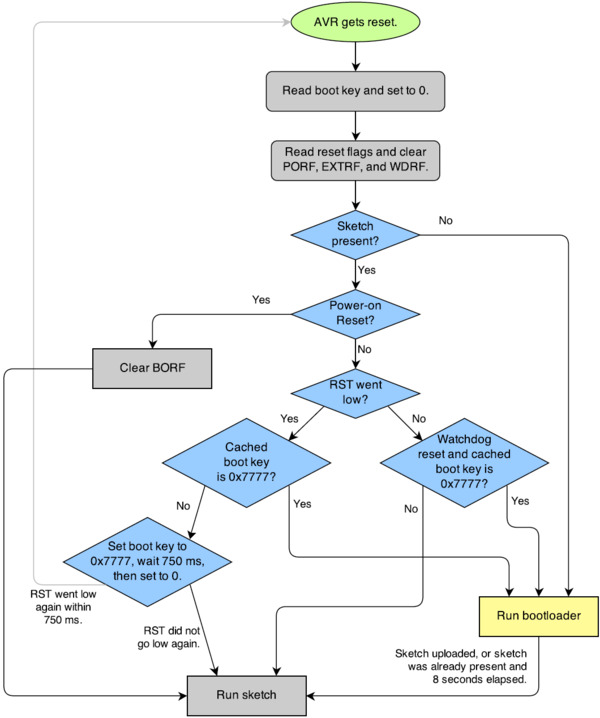 |
The startup logic for the A-Star 32U4 bootloader. |
|---|
Brown-out detection
Unlike many other ATmega32U4 boards, our 32U4 family of boards have brown-out detection enabled. The brown-out threshold is 4.3 V, and if the voltage on VCC goes below this then the AVR will reset. The bootloader was designed so that the user program can detect brown-out resets. To do so, check to see if the BORF bit in the MCUSR register is set, and then clear it later. Here is some example code you could put in your setup function for detecting brown-out resets:
pinMode(13, OUTPUT);
if (MCUSR & (1 << BORF))
{
// A brownout reset occurred. Blink the LED
// quickly for 2 seconds.
for(uint8_t i = 0; i < 10; i++)
{
digitalWrite(13, HIGH);
delay(100);
digitalWrite(13, LOW);
delay(100);
}
}
MCUSR = 0;
9. Reviving an unresponsive Zumo 32U4
In order to load a new program onto your A-Star 32U4 device, you will need to get it into bootloader mode and send programming commands to it over its virtual serial port using appropriate software. If you are programming the device from the Arduino IDE, the sketch loaded onto the device will generally support a special USB command for putting it in bootloader mode, and the Arduino IDE sends that command automatically when you click the Upload button. However, you might find yourself in a situation where the device is unresponsive and that method will not work. This can happen for two reasons:
- You accidentally loaded a malfunctioning program onto the device that is incapable of responding to the special USB command. For example, your program might be stuck in an infinite loop with interrupts disabled.
- You loaded a program which uses a non-standard type of USB interface or no USB interface.
The following sections provide different procedures you can use to revive your device.
9.1. Reviving using the Arduino IDE
This section explains three special methods for programming an A-Star (or another of our 32U4 family of boards) using the Arduino IDE in case your usual method of programming is not working.
Reset button
If you have an A-Star 32U4 Micro, you should connect a momentary pushbutton between the GND and RST pins to serve as a reset button. Other boards in our 32U4 family have a reset button you can use. Alternatively, you can use a wire to temporarily connect GND and RST together instead of using a reset button.
Resetting the board twice within 750 ms makes the board go into bootloader mode. The bootloader will exit after 8 seconds and try to run the sketch again if it has not started receiving programming commands. To revive the device, you need to make sure you start sending it programming commands before the 8-second period is over.
In bootloader mode, the yellow LED (the one labeled LED 13) fades in and out. It is useful to look at this LED so you can know what mode the microcontroller is in. Also, we recommend enabling verbose output during upload using the Arduino IDE’s “Preferences” dialog. Looking at the LED and looking at the verbose output during the following procedures will help you understand what is going on.
The substitute port method
This method has been tested on Arduino 1.8.19 and Arduino 2.0.3 but requires extra hardware.
- Connect a substitute serial port device to your computer. This should be a device that is recognized by the Arduino IDE as a serial port, but it should not be an A-Star 32U4, Arduino Leonardo, Arduino Micro, or any other device that disappears and reappears as a new device when a piece of software like the Arduino IDE opens the port, sets the baud rate to 1200, and then closes the port. It should also be a device that will not cause any problems if it receives data from the Arduino IDE. Here are some examples of substitute serial port devices:
- A USB-to-serial adapter such as the CP2102N
- A Pololu USB AVR Programmer v2.1
- An Arduino Uno R3
- A non-USB serial port such as
/dev/ttyS0on a Raspberry Pi
- Connect the 32U4 device to your computer via USB.
- In the “Tools” menu, open the “Board” sub-menu and select “Pololu A-Star 32U4”.
- In the “Tools” menu, open the “Port” sub-menu and select the substitute serial port.
- Click the Upload button. The Arduino IDE will compile your sketch and start uploading it.
- As soon as the box near the bottom of the IDE says “Uploading…”, reset the board twice to get into bootloader mode.
If you wait longer than 10 seconds to get the board into bootloader mode in the last step, the Arduino IDE will give up waiting for the bootloader’s serial port and instead attempt to send programming commands to the substitute serial port.
The uploading-before-bootloader method
The goal of the uploading-before-bootloader method is to select a non-existent serial port in the Arduino IDE and then make sure the Arduino IDE enters the uploading phase before the microcontroller goes into bootloader mode. This method has been tested on Arduino 1.8.19. This method does not work on Arduino 2.0.0 or 2.0.3 (and probably does not work on any 2.x versions) because those versions of the IDE give a fatal error message if the selected serial port is not present at the beginning of the uploading phase (“Failed uploading: no upload port provided”).
- Connect the 32U4 device to your computer via USB.
- In the “Tools” menu, open the “Board” sub-menu and select “Pololu A-Star 32U4”.
- In the “Tools” menu, open the “Port” sub-menu and check to see if any ports are selected. If the “Port” menu is grayed out or no ports in it are selected, that is good, and you can skip to step 6.
- Reset the board twice to get the board into bootloader mode. While the board is in bootloader mode, quickly select the new serial port that corresponds to the bootloader in the “Port” menu.
- After 8 seconds, the bootloader will exit and attempt to run the sketch again. Wait for the bootloader to exit. Verify that either the “Port” menu is grayed out or no ports in it are selected.
- Click the Upload button. The Arduino IDE will compile your sketch and start uploading it.
- As soon as the box near the bottom of the IDE says “Uploading…”, reset the board twice to get into bootloader mode.
The Arduino IDE will stay in the uploading phase for 10 seconds, waiting for a new serial port to appear. Once the serial port of the bootloader appears, the Arduino IDE will connect to it and send programming commands.
The bootloader-before-uploading method
This method has been tested on Arduino 2.0.3 but the timing requirements of the last step are so tight that the method might be impossible on slower computers.
- Connect the 32U4 device to your computer via USB.
- In the “Tools” menu, open the “Board” sub-menu and check to see if the “Pololu A-Star 32U4 (bootloader port)” entry is visible. If this entry is visible, you can skip to step 6.
- Using a text editor, open the file named boards.txt that provides the “Pololu A-Star” board entries. In Windows, you can typically find this file in %LocalAppData%\Arduino15\packages\pololu-a-star\hardware\avr\. In Linux, you can typically find this file in ~/.arduino15/packages/pololu-a-star/hardware/avr/. On macOS, you can typically find this file in ~/Library/Arduino15/packages/pololu-a-star/hardware/avr/. If you installed the boards manually instead of using the Board Manager, you can find it in [sketchbook location]/hardware/pololu/avr.
- In the boards.txt file that you opened, find the lines at the bottom of the file that start with
#a-star32U4bp. Uncomment each of those lines by deleting the “#” character, and then save the file. - Close the Arduino IDE and restart it.
- In the “Tools” menu, open the “Board” sub-menu and select “Pololu A-Star 32U4 (bootloader port)”. This entry is configured so that the Arduino IDE will send programming commands directly to selected serial port, instead of trying to send a special USB command to the port to get it into bootloader mode and then waiting for the new port to appear. By selecting this entry, the timing of the programming process below becomes easier, especially on Windows.
- Prepare the computer to show you a list of its virtual serial ports. If you are using Windows, this means you should open the Device Manager. If you are on Linux or macOS, this means you should open a Terminal and type the command
ls /dev/tty*but do not press enter until the board is in bootloader mode in the next step. - Reset the board twice to get the board into bootloader mode. While it is in bootloader mode, quickly look at the list of serial ports provided by your operating system in order to determine what port the bootloader is assigned to.
- In the Arduino IDE, click the “Verify” button to compile your sketch. This could make the timing easier during the next step.
- Reset the board twice to get the board into bootloader mode again. As soon as the yellow LED starts fading in and out, indicating the board is in bootloader mode, quickly select the serial port of the bootloader in the Arduino IDE (in Tools > Port) and then quickly click the Upload button.
The Arduino IDE will compile your sketch and then upload it to the selected serial port.
If the compilation of the sketch takes longer than 8 seconds, then this procedure will fail because the bootloader will time out and start trying to run the malfunctioning sketch again. If that happens, try the last two steps again using a simpler sketch such as the Blink example that can be found under File > Examples > 01.Basics > Blink. Also, make sure your computer is not too busy performing other tasks in the background, and make sure you performing the last step as fast as you can.
This method can also work in the older Arduino 1.8.19 with some modifications. You should select the correct port in the Port menu prior to the last step (e.g. by temporarily putting the board into bootloader mode and then selecting it). This makes the timing of the last step easier because you can just click the “Upload” button instead of clicking three times to select a port. Also, if the timing of the last step is still too tight, you can actually click Upload before putting the board into bootloader mode, but you need to get the board into bootloader mode while the IDE is still compiling, before the upload phase begins. (Neither of these optimizations are possible on Arduino 2.0.3 because it erases your serial port selection if the port disappears.) However, if you are using Arduino 1.8.19, the uploading-before-bootloader method documented above is probably easier.
After reviving your device, be sure to change the Board setting back to “Pololu A-Star 32U4” and select the right Port.
9.2. Reviving using AVRDUDE
This section explains a special method for reviving an A-Star (or another of our 32U4 family of boards) using the command-line utility AVRDUDE in case your usual method of programming is not working. AVRDUDE stands for “AVR Downloader/UploaDEr”, and it is compatible with the A-Star bootloader.
If you have an A-Star 32U4 Micro, you should connect a momentary pushbutton between the GND and RST pins to serve as a reset button. Other boards in our 32U4 family have a reset button you can use. Alternatively, you can use a wire to temporarily connect GND and RST together instead of using a reset button.
- Connect the device to your computer via USB.
- Prepare the computer to show you a list of its virtual serial ports. If you are using Windows, this means you should open the Device Manager. If you are on Linux or Mac OS X, this means you should open a Terminal and type the command
ls /dev/tty*but do not press enter until the board is in bootloader mode in the next step. - Press the reset button twice within 750 ms to make the AVR go into bootloader mode. You should see the yellow LED fading in and out when the AVR is in bootloader mode. While it is in bootloader mode, quickly look at the list of serial ports provided by your operating system in order to determine what port the bootloader is assigned to.
- Type the following command in your terminal and replace COM4 with the name of the bootloader’s serial port, but do not press enter yet. This command will erase the malfunctioning program on the device but preserve the bootloader.
avrdude -c avr109 -p atmega32U4 -P COM4 -e
- Press the reset button twice within 750 ms to make the AVR go into bootloader mode.
- Quickly run the command you typed previously. The command needs to be run within 8 seconds of starting the bootloader, or else the bootloader will exit and try to run the malfunctioning program again.
By following the instructions above, the malfunctioning program on the device will be erased and the device will stay in bootloader mode indefinitely. You can now load another program onto it using the Arduino IDE or AVRDUDE.
10. Related resources
To learn more about using the Zumo 32U4, see the following list of resources:
- The Arduino IDE has many examples that can run on the Zumo 32U4 (although note that the Zumo’s on-board hardware might conflict with some of these examples).
- The Arduino website has a Language Reference, a wiki called the The Arduino Playground, and other resources.
- The Zumo 32U4 uses the same microcontroller as the Arduino Leonardo and Arduino Micro, so you can search the Internet for relevant projects and code examples that use one of those boards.
- Atmel’s ATmega32U4 documentation has the ATmega32U4 datasheet and many related documents.
- AVR Libc Home Page: this page documents the standard library of functions that you can use with GNU C and C++ compilers for the AVR.
- Zumo 32U4 Arduino library
- Zumo32U4 library documentation
- LUFA – the Lightweight USB Framework for AVRs
- WinAVR
- Microchip Studio for AVR and SAM Devices
- AVRDUDE
- AVR Freaks
Datasheets for some of the components found on the Zumo 32U4 are available below:
- ATmega32U4 documentation
- Texas Instruments DRV8838 motor driver datasheet (1k redirect)
- Sharp GP2S60 compact reflective photointerrupter datasheet (164k pdf)
- Vishay TSSP77038 IR receiver module datasheet (268k pdf)
- ST LSM6DS33 3D accelerometer and 3D gyro module datasheet (1MB pdf)
- ST LIS3MDL 3-axis magnetometer datasheet (2MB pdf)
- ST LSM303D 3D accelerometer and 3D magnetometer module datasheet (1MB pdf)
- ST L3GD20H three-axis digital-output gyroscope datasheet (3MB pdf)
- Texas Instruments TPS2113A power multiplexer datasheet (1k redirect)
Finally, we would like to hear your comments and questions on the Robots section of the Pololu Robotics Forum!

